







Ihadthe pleasure of hosting a group of potential inward investors from GB recently, who captured where we are so well and so simply with the words: “Northern Ireland is at an inflection point.”
We are in one of the best positions I have known in my lifetime – to quote UK Prime Minister Rishi Sunak, we are the “world’s most exciting economic zone”. Such powerful words - full of optimism and opportunity for our special place. Of course, this opportunity brings with it responsibility. Will we be the generation that changes the trajectory of our economy to become one of inclusive prosperity, benefiting all who live here? Will we start to make this place sustainable in all senses – economic, environmental, and social?
I can’t think of a more fitting way to open Sync NI’s Innovation edition than to encourage everyone to be innovative.
Innovation is not the preserve of a select few. Nor does it require technology, qualifications or shiny buildings – it’s achievable for all of us. Innovation is simply about doing things differently – rather than blindly following convention. It’s about finding new processes and new paths. It’s having the courage to try new approaches and doing new things, taking some risks along the way.
Let’s look for solutions instead of problems and adopt and live that “can do” attitude that we’re becoming world famous for. Our ambition must be to lever all the capacity, capability, and assets we have to become a region of fixers – fixing society by fixing the economy.
It's important to recognise and be grateful for how far we have come. But the landscape and
context we work in is now very different. The tools we used to get us here will not be the same tools we use to shift the next dial.
But we’re poised to do just that.
At times, I think that others believe in us more than we believe in ourselves. Our list of accolades across key sectors continues to grow.
Here’s just a sample:
1. 75% of international companies that come here reinvest.
2. We are the world’s top region for FinTech inward investment.
3. There are almost 20k people employed in Health and Life Sciences in more than 250 companies, supported by our two world class universities, which are in the top five in the UK for bioscience impact.
4. We are global market leaders in crushing and screening equipment.
5. Our region is the place to make Oscar winning films, top performing TV series and award-winning documentaries. We’re on the global stage, with screen and media production Netflix, Paramount, HBO, BBC, Britbox and many others choosing NI. With Studio Ulster’s virtual production facilities being finalised next year thanks to Belfast Region City Deal investment, this trend is set to continue.
6. Our local start-up and scale-up companies raised a record breaking £140m in 2022 and Qubis Limited consistently ranks number one in the UK for entrepreneurial impact.
So, it’s more of a call to action than a foreword from me.
Let’s get our collective shoulders behind the wheel of opportunity, make it move at pace and let our wonderful place sing, instead of shout.
About Sync NI
Sync NI is proud to be the voice of Northern Ireland’s vibrant technology and business sector.
The Sync NI website and magazine brings readers the latest tech and business news, views, jobs and events in Belfast and beyond.
Sync NI Contacts
Editorial
Phone: 028 9082 0944
Email: team@syncni.com
Advertising & Partnerships
Phone: 028 9082 0947
Email: louis@syncni.com
General Enquiries
Sync NI
Rochester Building 28 Adelaide street Belfast
BT2 8GD
Phone: 028 9082 0944
Email: team@syncni.com
Online: www.syncni.com
Copyright No part of this publication may be reproduced without the written permission of the copyholder and publisher. Sync NI accepts no responsibility for the accuracy of contributed articles or statements appearing in this magazine and any views or opinions expressed are not necessarily those of Sync NI, unless otherwise indicated. No responsibility for loss or distress associated to any person acting or refraining from acting as a result of the material in this magazine can be accepted by the authors, contributors, editors or publishers. Sync NI does not endorse any goods or services advertised, nor any claims or representations made in any advertisement in this magazine.
06 New demands emerge as the rise of digitisation continues
10 A Menacing Shadow: Testing the boundaries of AI and ChatGPT
12 Q&A with John Harkness, CME Group
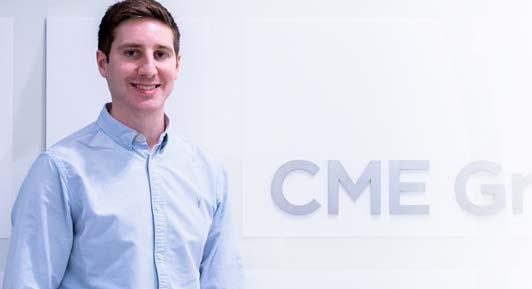

14 Citi Belfast doubles-down on commitment to breaking barriers to entry

16 Are you engineering for happiness?
18 Aflac’s rising success in Belfast

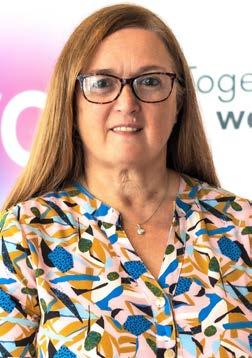
20 Rapid7 strive to revolutionise working in the cybersecurity sector
24 Innovation at ESO
26 Kainos update headquarters with brand-new office extension and collaboration space

29 Demand for more secure technology: A call to action from Cyber UK 2023 at Belfast

30 Belfast’s booming innovation sector sparks ideas and drives investment for Northern Ireland

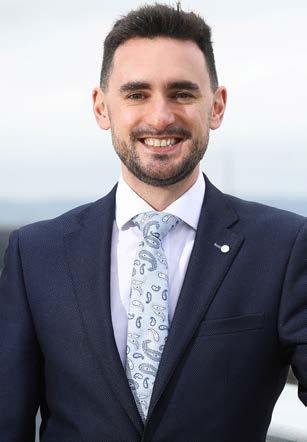
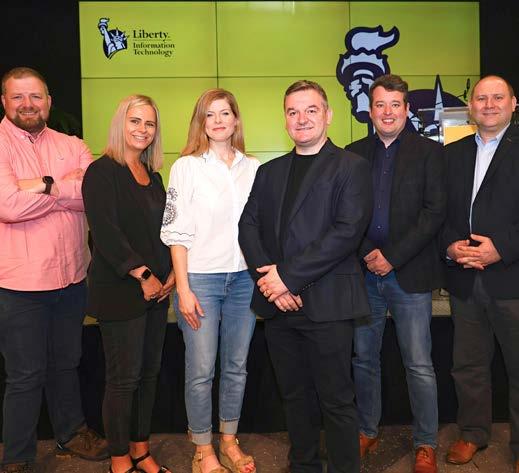


32 FirstUp announces plans to expand their workforce
34 What new technologies are right for your business?
36 Animotive: Transforming the Landscape of 3D Animation Production
39 Over 70,000 companies can’t be wrong – are you?

40 Liberty IT opens new Galway hub and announces the creation of 100 new jobs
42 Life and Health Sciences put NI on the map as a potential global market leader
44 Version 1 strives to be an innovative leader of tech
46 PA Consulting strives for an innovation-led future
47 Cybercriminals are evolving their tactics; Organisations must innovate to keep pace
q How much has demand increased for services and products that are integral to support the digital economy?
The growth in digitalisation is having a profound impact on the demand for high-capacity connectivity, cloudbased services and security across all organisations, public and private across Northern Ireland. As they strive to maintain high levels of customer service, employee experience and overall operational efficiencies, their digital infrastructure must remain one step ahead.
Over the 15 years I’ve been with eir evo there has been exponential growth in demand for bandwidth. It wasn’t that long ago we would have client sites with 100 staff requiring 10MB, today these same sites are now requiring a minimum of 1GB with many opting for 10GB. Now that hybrid working has proven to work, people are travelling less to offices and are becoming increasingly reliant on Unified Communications and internet connectivity. Together with an explosion in video calls, which is inherently bandwidth-intensive, this is driving increased demand for bandwidth. In general, organisations need to move data fast ensuring that everything is available across their networks and people have access to the information they need on demand.
Cloud computing has also had a transformative impact on the business world, offering greater scalability, flexibility and cost savings. It has opened up access to powerful technologies for organisations of all sizes. Cloud adoption is becoming much more widespread

Diane Giles, Head of Service Delivery at eir evo UK, explores how new tech is assisting businesses to overcome barriers
and customers are looking to us to help them with their cloud migration and provide them with access to cloud services, including compute, analytics, storage and networking.
Coupled with the growth in digitalisation, cloudbased applications and access-anywhere, security is obviously a major consideration and keeping data secure is one of the top priorities for our customers. The most notable growth areas are in user identity and access management, along with proactive services for detection and response of security threats and incidents.
Companies often rely on trusted technology partners for the additional skills they need, allowing their in-house teams to concentrate on their core business and doing the things they do best. They want a partner with high levels of expertise to give them valuable trusted advice, rather than a technology vendor who just sells them something that they may or may not need.
q How are organisations keeping up with this demand in terms of the availability of skills?
The core of our business is delivering managed services, literally taking away the headaches of day-to-day management of networks and IT Services. In the past, you might have had a number of people in a business tasked with keeping networks or IT Services operational. Today with the pressure on resources and costs, we can help streamline these functions with our expertise and the automation of tool sets.
The Universities in Northern Ireland have always produced very high calibre ICT graduates, but there is a limited amount of that talent.
Finding talent in the first place can prove difficult, but there is also the additional challenge of retaining experienced key staff. Like every business, we understand the necessity of getting the right people and building them up to have the knowledge and skill sets for the job. Our policy is to delay filling a role rather than to hire the wrong person. eir evo always looks for somebody who is a good fit for the business and who has the right attitude. Although you can train somebody on how to do a job, you can't train them to have the right attitude. From a customer’s perspective, it’s imperative that they are engaging with somebody who actually cares and genuinely feels a responsibility to do a good job. We have employed people with non-IT backgrounds looking for a career change and keen to do a great job, put them through training on technical skills, and they have turned out to be
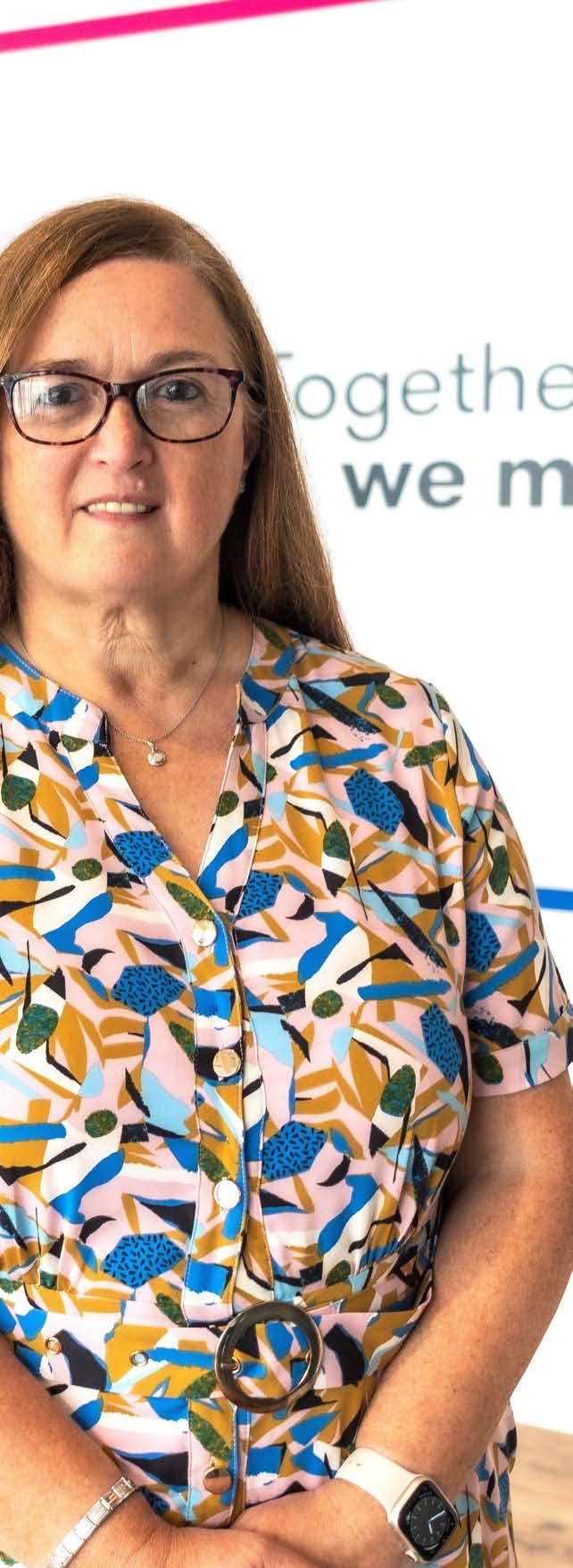
some of our best engineers.
q As technology becomes more pervasive how does eir evo innovate to deliver evermore complex solutions for its customers?
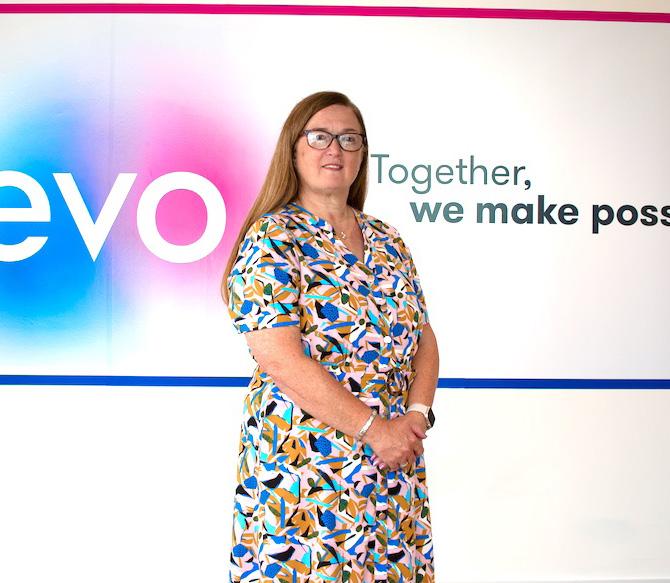
The key thing for us is our partnerships with all the leading vendors. We are Microsoft Partner of the Year, HPE Partner of the year and Cisco Partner of the Year so we have really strong partnership relationships behind us and very strong accreditations. Many companies may not have the scale or ability to have certified experts in their business and it takes a long time and a lot of investment to attain these levels of expertise. We leverage those premium relationships to build our knowledge, share it with our customers and innovate on their behalf.
Working with our partners means we can deliver the very best in class solutions from a wide portfolio of services to help our customers stay ahead of the curve. Our partners are always investing in the latest emerging technologies - AI, edge-computing, hyper-automation and so on. Working together, we can leverage these technologies to enhance productivity, improve customer experiences and drive innovation for our customers.
q What are the key success factors in delivering these complex solutions?
Firstly, it's expertise.
Knowing what you're talking about is crucial for success. Also, you need to be focused on what the customer needs and what the problem is. Sometimes we can all be guilty of thinking we know what the problem is and what will deliver the customer requirement but actually something slightly or totally different might be a much better fit. Our job is to dig deeper into the actual challenges faced by our customers, to understand what the real problems are, and to provide the best solution at the best price.
We pride ourselves on our excellence in service delivery so we take it as a challenge to always do things well and we have a record of delivering to very tight timescales over the years. This was evidenced particularly over COVID when it was very difficult to even get into customer sites. For one customer we deployed 90 sites in four months and while it was challenging during a global pandemic to get access to sites, we met all our project milestones and customers can trust us to deliver.
Communicating with customers is also very important. Being open and honest is critical to building trust and even if it’s not the news they want to hear, telling them exactly what’s going on is critical. Where problems occur, we explain these in an open and truthful way, along with our plans to rectify them. Also, in our environment things can change quickly so being
adaptable to change is essential. What a customer might have needed six months ago might not be what they need today.
Being local is a very important aspect for our customers and something I am personally very proud of. Our strong local team in Northern Ireland are all users or customers of the services that we deliver. Whether it’s schools, councils, hospitals, hotels, food production or the many other sectors we service, the team wants to go the extra mile to make those services the very best they can be. Being local also means that the individuals working on a project from the customer’s business and from our own teams get to know one another and can operate like true partners.
Obviously there are a number of areas where AI is starting to make a big impact. For us right now we are looking at software defined network automation, reporting and analytics
where AI will be able to do some of the lower level tasks. But there is still a need for somebody to apply some human thought to things. Being able to configure tasks that are repeatable without mistakes is definitely a place where AI can have a positive role.
In terms of security, AI will be able to see trends and look for certain things probably much quicker and much easier than a human can. Ultimately application development is a really key one for us and we see AI coming into its own here. Code generated by a robot will speed things up massively but there will still be a need to apply human thought to ensure the output of AI delivers what is required.
Our focus is on having the right team, with the right skills, backed up by the best toolkits to deliver our customer expectations because those are the key components of a high quality service organisation.
Together, we make possible.






The state-of-the art network in our new Belfast campus sets a new gold standard which is being rolled out to all our campuses. eir evo’s design & delivery approach has been crucial to its success.

David Collins, CEO at First Derivative, discusses how AI will change how humans and businesses operate with assistance from these emerging technologies

Something has happened in the world of AI. The emergence of Chat GPT, has passed a watershed moment in computer science or crossed the Rubicon if you prefer more drama - Chat GPT has passed the Turing Test.
We could argue that mastering natural language will do for working in words what calculators and spreadsheets did for working in numbers. To test that I asked Chat GPT to help me write this
article. At the first attempt, it produced a fairly bland, ‘me-too’ block of text with no interesting insight or angles. I gave it some direction and it wrote a second version dramatising the risks and gave it a title of ‘the menacing shadow’, it still didn’t come up with anything I hadn’t heard before.
If I was hoping for a ‘Move 37’ moment I was destined for disappointment. Perhaps that is not surprising, firstly because my test was very narrow
and hardly scientific in its approach and secondly that isn’t what Chat GPT was trained to do. It is a very specific application of AI, broad in its understanding of language but limited to a specific use case.
One thing to be aware of is the different algorithmic techniques that AI uses, this ranges from simple logic trees that could be defined in the same way as sarcasm is to wit, to the more mysterious neural networks that do
produce ‘Move 37’ moments, when applied to certain types of scenarios. Not all techniques are applicable to all use cases and the more sophisticated AI systems will often nest different approaches together.
What they do have in common is they require two fuel sources, compute power and data. Training any algorithm requires a lot of data, it needs to be collected (created where there is insufficient access), cleaned, modelled and processed. The more sophisticated the
ask the more support of associated data is required, we need to understand the context and where humans are involved, something about the emotional state that produced the actions. These tasks are continuous, as we deploy the AI we gather information, learn, enhance the data set and retrain. More data and more compute power is required to retrain the systems.
The use of AI to undertake certain tasks that previously required human interaction will bring the technology

revolution to more parts of the economy, it will inevitably make certain roles redundant but I don’t share the fear of mass unemployment; the AI revolution will certainly create new roles for data analysts, data scientists and data engineers. The new demographic paradigm is crying out for machines to help in a world where we will not have enough workers. I could argue that we seriously need these tools to face a future where the workforce is declining.
Having said all of that, the ‘menacing shadow’ article produced by Chat GPT has some merit. It is inevitable that this technology will be weaponized, if it hasn’t been already and if you combine that with the technological singularity - the point where AI becomes capable of recursive self-improvement and surpasses human intelligence, we could get closer to that sky-net moment.
I think we are a long way from that point and the more immediate issue is our own self-worth as we become more attached to our generative tools from Stable Diffusion for image manipulation through to Chat GPT. These are augmentation tools; used well they make us more productive but create a dependency that removes some of our creativity. How do we really feel about AI producing art be it photographs, works of art, music or images? Can we celebrate the creativity
programmed into a machine to produce images in the style of Ansel Adams in the same way as we did the original? As smart as it is to build a neural network that can be trained on Adam’s back catalog it is a long way from the sense of journey through Yosemite, shots taken using 35mm film and the manual development process.
Perhaps we need to revisit Turing's original question that he posed in his 1950 paper “Computing Machinery and Intelligence”, he originally asked “can machines think” but given the lack of definition of the word think he avoided the question proposing instead his natural language test. Would we define ‘Move 37’ as thinking or was it random brilliance?
When faced with a scenario that requires a decision, we could code a machine to make that decision based on a series of inputs that are not based solely on deterministic decision trees and where the outcome is uncertain i.e. we only know if it was the right decision retrospectively. I suspect the computer could be at least as right as any human. It’s possible then to understand why Alan Turing selected the natural language test as the best example of thinking.
Perhaps we need to propose a new test of human-like behaviour based on Philip K Dicks dystopian novel ‘Do androids dream of electric sheep?’ How would we feel then if we discovered a machine dreaming?
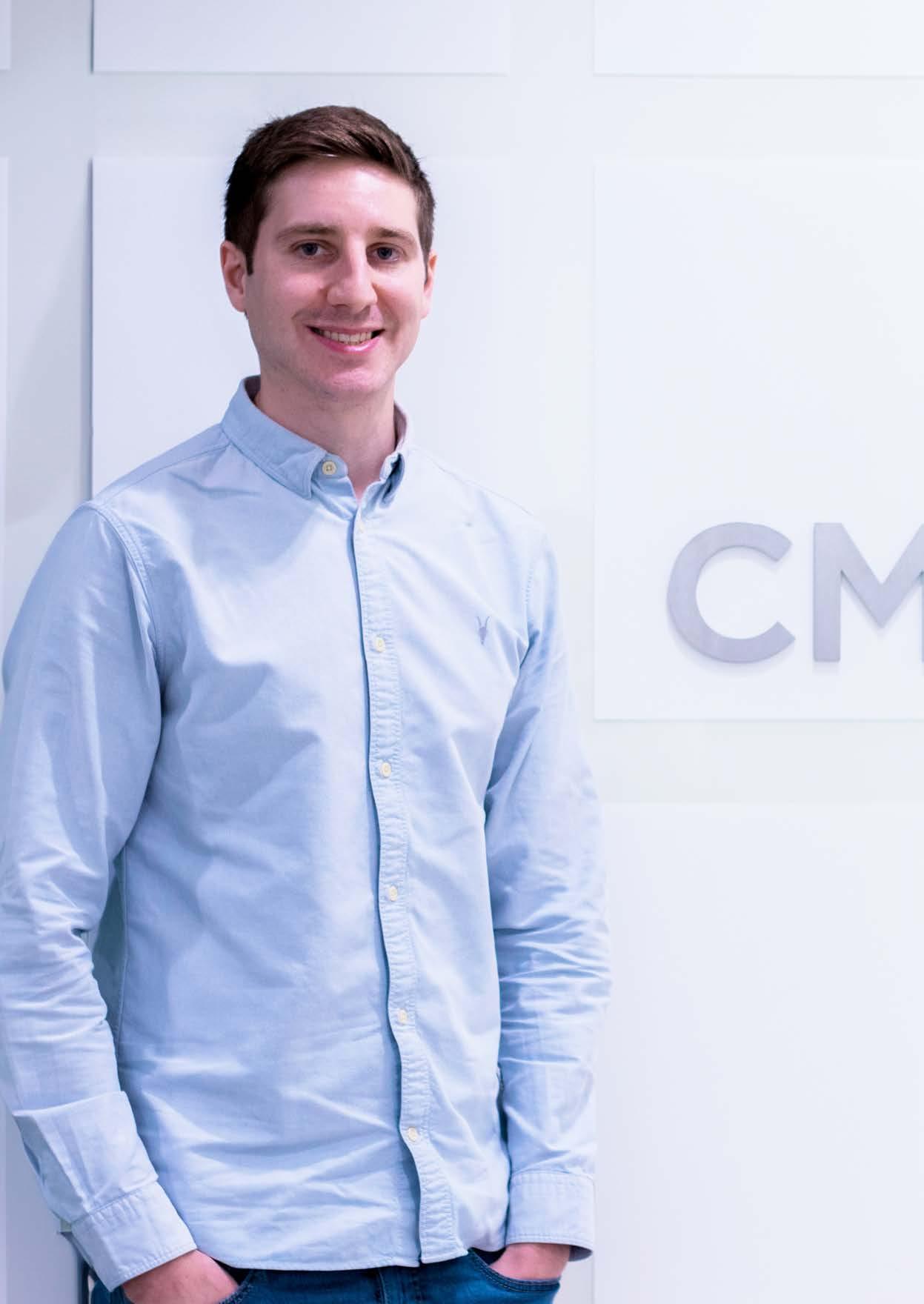
q Clearing is an essential part of derivatives exchanges – can you briefly explain what this means?
Clearing is all about risk management. When two parties trade on CME Group’s exchanges, they have contractual and financial obligations to one another such as payment of cash or making/taking delivery of a commodity. There is a risk that a party to the trade may not meet their obligations to the opposite side. This is what is known as counterparty risk and where clearing comes into play. CME Group’s clearing house becomes the central counterparty to the buyer and seller in a transaction, which mitigates counterparty risk and ensures parties meet the contractual and financial obligations of a trade.
As well as acting as central counterparty to all trades, CME Group’s clearing house mitigates other forms of risk through various methods including requiring customers to route their trades through registered clearing member firms, collecting collateral to cover initial margin and moving mark to market on open positions.

q Have these processes evolved much over the last 8 years since you started with CME?
It’s a great question, strangely yes and no. It’s a no in the sense that many of these risk management processes applied over 100 years ago when our clearing house was first founded clearing agricultural commodities like butter and eggs. It shows how our business has stood the test of time and how clearing
safeguards financial markets.
However, it is also definitely a yes! When I look at the past 8 years since I started at CME Group, we have continually launched new products, developed cutting edge trading/ clearing systems and come up with new clearing solutions, all of which drive capital efficiencies for our customers and enable them to hedge their risk.
q Is there much room to innovate in your sector and where can improvements in Risk management be achieved?
Definitely. At CME Group you can trade futures and options on equities, FX, interest rates, agriculture, energies, metals, cryptocurrencies, weather and environmental contracts, as well as interest rate swaps. We are always looking to innovate by growing our product base and offering new types of contracts to our market participants. We want our markets to be as liquid as possible and to help participants manage risk in volatile periods. This is only possible by striving to innovate and embracing new ideas and technologies. We continually look at new ways to drive margin efficiencies for our customer base such as offering various cross margining programs and developing new risk methodologies.
Technology plays a big part in risk management too. Meaningful, low latency, real-time data and information are critical to make decisions in the risk management space, both for CME and its customers.
q Is technology the answer to everything in the future or will we still require a human touch? Personally, I think technology is an enabler that drives things forward but not without human intervention. One example is when CME Group
launched Globex and many of its markets moved from open outcry trading floors to electronic trading. There was technology involved for sure, but it couldn’t have happened without human touch and it is still humans on the other end of the trading screen. Even with algorithmic trading and risk modelling there is human intervention, be it designing or validating a model.
We have also seen how technology has improved things in our day to day lives but sometimes it goes wrong and we need real people to fix it. I don’t see that changing any time soon. I think we also take comfort that even in the world of automation, we have humans in the background performing checks and making sure things are running as they should be.
q What new skills will be required for the FinTech companies of tomorrow?
Knowledge around cloud computing and low latency technologies is undoubtedly important to any FinTech company. CME Group is partnering with Google to move its own trading and clearing systems to Google’s cloud platform. This is a big task but will provide us with many benefits. This year CME Group had its highest trading volume day in its history, when over 66 million contracts traded on our exchange. When you look at it that way and think about the volume of data that needs to be processed in a low latency manner, cloud computing, big data and low latency systems will become increasingly important.
AI is a hot topic too. I think it will be a useful tool for young technologists to drive things forward but it is also important to learn its intricacies and protect society from unintended consequences.
CME Group’s Director Clearing Operations and Risk sat down with Sync NI to discuss the future of Fintech
Citi Belfast have continued their mission to challenge misconceptions of careers in the financial and professional services and encourage more people from diverse backgrounds to consider careers in the sector with the recent announcement of their Citi Career Empowerment Programme.
Citi offer many diverse career pathways and routes to entry, and
the newly-launched Programme is designed to continue attracting an increasingly diverse talent pool and will work to remove social inequality barriers, develop skills and improve employability.
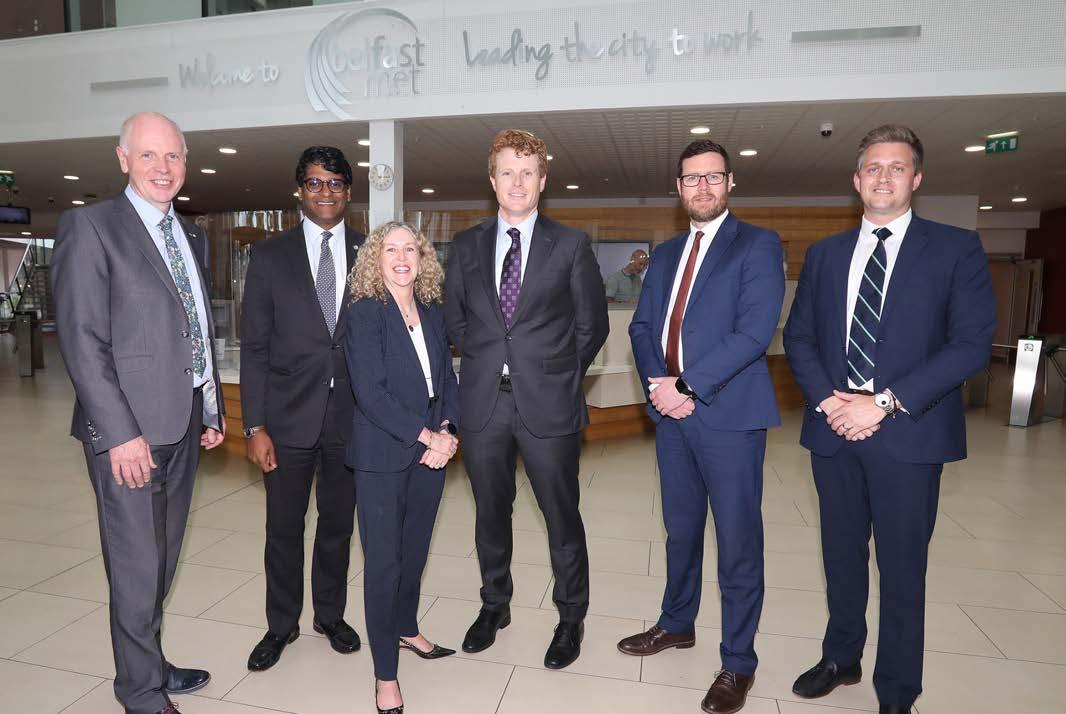
The launch of this programme in collaboration with Belfast Met is a leap forward, engaging with the Department of Economy’s economic strategy’s three pillars of innovation, sustainability and inclusion and will equip people across
Northern Ireland with the skills needed to succeed in a lifelong professional career.
Through collaboration with a range of key influencers and local stakeholders within the financial and professional services sector, and Invest NI, Citi aims to develop and implement a range of programmes to remove barriers and provide recognised skills and qualifications to reduce the high rate of economic inactivity across Northern
Ireland. Citi’s Career Empowerment Programme will create a more diverse workforce, build better community relationships, and continue to solidify Citi’s reputation as an inclusive employer.
The employer also took a leading active role in developing the unique Northern Ireland FinTECH and Professional Services Programme which recently launched at Belfast
Met with Joe Kennedy, US Economic Envoy to Northern Ireland present. The innovative programme aims to give young people not in education, training or employment the pathway to a growth industry career in a range of areas including business, digital, fintech and professional services. The programme will include project based learning placement in Citi and other partner organisations which will involve mentorship to build confidence and soft skills which are key to employment and progression.
Leigh Meyer, Citi Belfast

Site Head said: “Citi believes that everyone can belong in banking, and as the global bank’s customers continue to grow in diversity, it is crucial that our growing team reflects that diversity. The launch of our Career Empowerment Programme will ensure a wider range of voices and backgrounds are present within our workforce and
reinforces our commitment to providing jobs to people here in Northern Ireland. As the only global investment bank operating in Northern Ireland, we are proud to be opening the doors for more people to live locally and work globally, supporting businesses around the world.”
“A common theme for Citi Belfast since our establishment has been that of identifying and removing barriers for entry. We offer a range of career pathways to encourage everyone to consider a career at Citi. Our
diverse programmes include apprenticeships, graduates, reactivate your career, and business academies. We offer the training and support required for career progression and actively champion and empower our team’s growth and success by creating a culture defined by inclusion to create a vibrant working environment for all.”
Citi started its business in Belfast in 2005 with an original plan of recruiting 375 technology staff to deliver services to Citi’s global institutional clients
group. Since then, Citi has grown to be Northern Ireland’s largest financial services employer by tapping into the deep and broad talent pool in Northern Ireland and engaging with universities and other higher learning institutions to develop a strong pipeline of talent which has facilitated the continued growth. Citi is now a strategic delivery centre for many of the bank’s 21 global functions including Legal, Compliance, HR and Markets Operations.
During the pandemic, Citi employed an additional 1,000 new people in Belfast through organic growth and internal transfers and in early 2022 announced an additional 300 jobs covering all levels, from apprentices and graduates to experienced roles. Far surpassing growth projections, Citi now employs over 4,000 members of staff over four locations in Northern Ireland. Citi’s team includes over 40 nationalities working within its local team in Northern Ireland and also benefits from five inclusion networks including: Disability, Families Matter, Multicultural, Women and Pride which champion diversity, equity and inclusion across the firm. Citi Belfast also works with external partners to create positive impact in local communities and has raised over $1million for sponsored charities in the last 5 years.
For more information on Citi’s Career Empowerment Programme visit Belfast Met‘s website.

After the Great Resignation, many of us have been left wondering why we do our jobs. Earning money is essential, of course, but we’re searching for greater meaning — from our careers, our lives, and everything we do. What if I suggested that we do our jobs, especially some of our more technical work, to create happiness? I know happiness sounds like a lofty goal, and one that feels far removed from the daily grind, but it is actually made up of many small moments of joy throughout the day.
What, exactly, is happiness? Definitions vary, but typically include joy, satisfaction, and fulfillment. Happiness may not be as exciting as euphoria or rapture, but it’s also more achievable — it’s simply not practical to feel the most intense emotions all the time. That’s why I like to define happiness as contentment, a feeling that can underpin your various moods all day, every day.
For example, let’s step into the shoes of a software engineer for a minute. Taking on a task and coding a solution may not sound particularly “happy,” but dig a little deeper. Being assigned a task is a gesture of trust, and should be celebrated as recognition, rather than being viewed as a chore. And the problem-solving process can result in exhilarating “eureka moments” and the deep satisfaction of finding a solution. Then there’s the production and release, when innovative technology really comes to life. There are plenty of daily opportunities for happiness in this job, and the possibility of deeper contentment is built-in.
Software engineers follow a number of modern programming principles, including simplicity, receptivity to feedback, and end-goal mindfulness. These very same guidelines apply to happiness, giving developers a built-in opportunity to find contentment.
Take simplicity, for example. It is parsimony in algorithm design, simplicity in systems design (the KISS principle), or the global minima in your ML algorithm. In product thinking, it is doing more with less, or even just doing less. There is elegance, clarity, and purity in simplicity — and a simple life without excess worries and drama is more likely to also be a happy life. After all, that’s why it’s often said that “simplicity is the key to happiness.”
Another essential aspect of software engineering is feedback, including periodic reviews, formal QA, and post-launch bug reports. This feedback is intended to improve our work and
how we approach it — making it a springboard to achieving happiness. Consider this: autonomous work, which most developers love, is only possible when there is a robust feedback loop. In other words, regular assessments give us the freedom to work our way, creating the best possible outcome. A great outcome achieved independently sounds like a developer’s dream.
A third principle we follow is keeping the end goal in mind at all times. This alignment with the big picture increases the value of our individual efforts, keeps us moving forward, and reminds us that we are creating real business value. This mindfulness does not diminish our individual contributions; rather, it amplifies everything we do, because the whole cannot work without top-notch components. Being part of a big project can certainly contribute to a sense of purpose and happiness.
Although we do carry out many tasks ourselves, working together towards a shared vision is a vital aspect of all successful engineering teams. Teamwork is a powerful aspect of happiness because it allows us to achieve more than we could alone, while also providing a sense of belonging.
A sense of belonging is considered a basic human need — and is especially important at work, where we spend so many waking hours. The best workplace team isn’t built on friendship, it’s built on trust. When we encounter difficulties, working together makes us more resilient. When we are overwhelmed, having teammates can lighten the load. When we celebrate success, we have others to share the fun. Our teams are the source of so much joy, satisfaction, and fulfillment at work.
There’s one last really important aspect to building happiness at work: kindness. It’s hard to quantify, which means it’s often overlooked in corporate culture, but it’s so essential. As an expression of empathy and friendliness, kindness assumes that we’re all looking out for each other. As agile practitioners, we are always practising empathy through user stories, which let us imagine being end users.
As we search for happiness, we must cultivate it at work. Fortunately, engineering departments can offer an ideal environment for finding both individual contentment and team camaraderie. And based on my own experiences at Apex Fintech Solutions UK in Belfast, I know that when we strive to be happy at work, we can accomplish truly amazing things.
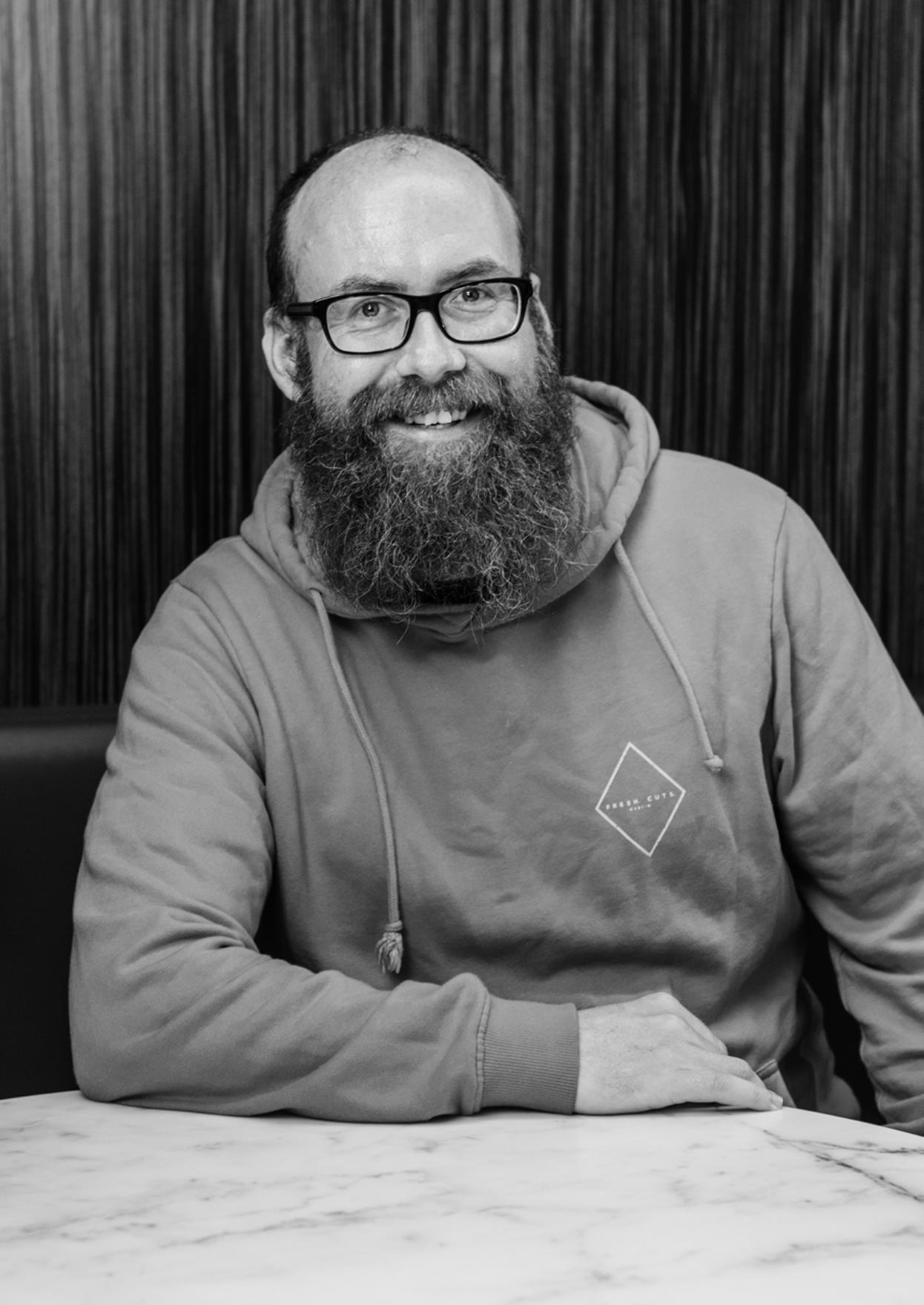
Sync NI spoke with Mark McCormack, VP and Managing Director at Aflac Northern Ireland, to discuss their journey so far and how they have settled into their brand-new offices at the recently completed, Grade A office development City Quays 3
Aflac, a Fortune 500 company and the No. 1 provider of supplemental health insurance products in the U.S. as well as the leading provider of cancer and medical insurance policies in force in Japan, established its Technology and Cybersecurity Innovation Centre in Northern Ireland just four years ago. Today, Aflac Northern Ireland employs over 150 people working in technology, software engineering and cybersecurity.
It’s impossible not to be in awe of the stunning panoramic views visible from standing on top of Belfast’s landmark City Quays development, reported to be the tallest office building in Northern Ireland. Overlooking the entire city and beyond, it commands views over the historic shipyard and Belfast Lough, including iconic landmarks from Belfast Castle on one side to Scrabo Tower in Newtownards on the other. The view even extends all the way to the Mourne Mountains in the distance. The purposeful interior design of the offices themselves are no less impressive, and the space has been designed to inspire and encourage creativity, imagination and of course innovation.
Mark explained that careful consideration went into the design to ensure that the new building reflects Aflac’s culture as an organization, a place where people come together to be creative and collaborative. As a near 4-yr-old tech company, with a stated purpose to “deliver a frictionless digital experience for our customers in their time of need”, bringing new ideas to the fore is key to unlocking the potential that technology brings.
Standing on the balcony of the 16-story building overlooking the city, this is a place that the entire team can draw on for inspiration. Mark explains how “Being at the same height as the famous cranes and overlooking Belfast can give you a new perspective to think about your problems in a different way. Problems that may feel overbearing and hard to overcome at ground level are easier to solve when you’re at a distance and able to see the bigger picture. I genuinely believe having this physical perspective drives a mindset and attitude to make complex problems more solvable.”
Mark went on to explain how Aflac draws inspiration from Belfast’s historic past as a leader in innovation and great design thinking. He pointed over towards the docks and talked
passionately about how proud he was to be located in the part of Belfast that once drove the economy of the region. In the past Northern Ireland was renowned for its shipbuilding, linen-making and ropemaking but today that engineering heritage that once made the city famous has reemerged in different guises. Now 100 years later Northern Ireland is recognized globally for its successful cybersecurity, software development and world-class film studios. All of this inspires Aflac Northern Ireland as they look to the future.
As you would expect, innovation is high on Aflac’s agenda, and numerous programs and initiatives are in place to ensure a culture of innovation is imprinted throughout the business.

Mark iterated this with a nod to Northern Ireland’s rise in recognition. “This part of the world has always been a leader in innovation and implementing new ideas, new systems, and new technologies. We bring that mindset to Aflac as well.’’
Mark described how Aflac team members take part in a 12week Innovation Program where they get the opportunity to step out of their role and embrace their creative curiosity as they learn about how to apply innovation to challenging business problems. The wealth of business knowledge and range of skills they bring back into their teams after 12 weeks is quite remarkable – from design-thinking concepts to a new appreciation of the customer’s journey, it’s an incredible way for the teams to develop. Mark also cited a recent example of an in-person session named ‘’Blocker Busters” which involved 80 team members split into groups of people from across all of the teams to address ‘blockers’ in processes or technology. The goal was to identify those issues and collaborate to create innovative solutions to clear the path for those facing similar challenges. After a recent review, it was pleasing to see that many of the blockers had been alleviated as a result of this particular session. Mark acknowledged that through the teams’ collaborative spirit this helped to create several useful learnings that will be embraced by the company for the future.
When asked about how new technologies might impact the business, Mark believes that in the future the integration of AI will undoubtedly bring more change but change for the better. By strategically leveraging AI and new technologies he believes that AI will be an enabler to remove mundane tasks and ‘focus our time on what human being are best at. This means being empathetic, being creative and spending time
together as human beings. Let machines take care of the mundane and we’ll take care of the people.’
Automation is another hugely important area for Aflac’s business and they are dedicated to improving the customer experience, particularly given the emotional aspects and sensitivities of the coverage Aflac provides. As Mark explains, when a customer makes contact, they might be having one of the worst days of their lives –whether that’s a really challenging medical diagnosis or a child that is sick or injured –so it’s essential that Aflac’s digital solutions deliver a frictionless experience for their customers.
Aflac Northern Ireland are working on some of the most important projects for the business such as the policyholder app, ‘MyAflac’, allowing customers to selfserve by submitting their claims online. The team are working to make the claims process touchless so it can all be processed automatically using the technology without any human intervention. As a result, customers are able to receive their money in a day or two rather than a week, which is the typical processing time for most companies.
Aflac are also developing AI and machine learning capabilities to further automate their processes and by using intelligent solutions they can provide a much-improved customer experience. AI can assist by generating recommendations for claims specialists to make sure customers are getting the correct money and benefits and give them what they need to get on with their daily lives.
In a relatively short period of time, Aflac Northern Ireland have grown to a 150-strong organisation, where talented professionals can succeed, and know that they have a clear purpose. Aflac’s investment in one of the most impressive spaces in the city, shows how much they value the innovation from their employees, and builds on the impressive legacy of Belfast, whilst pointing to huge opportunities in the future.
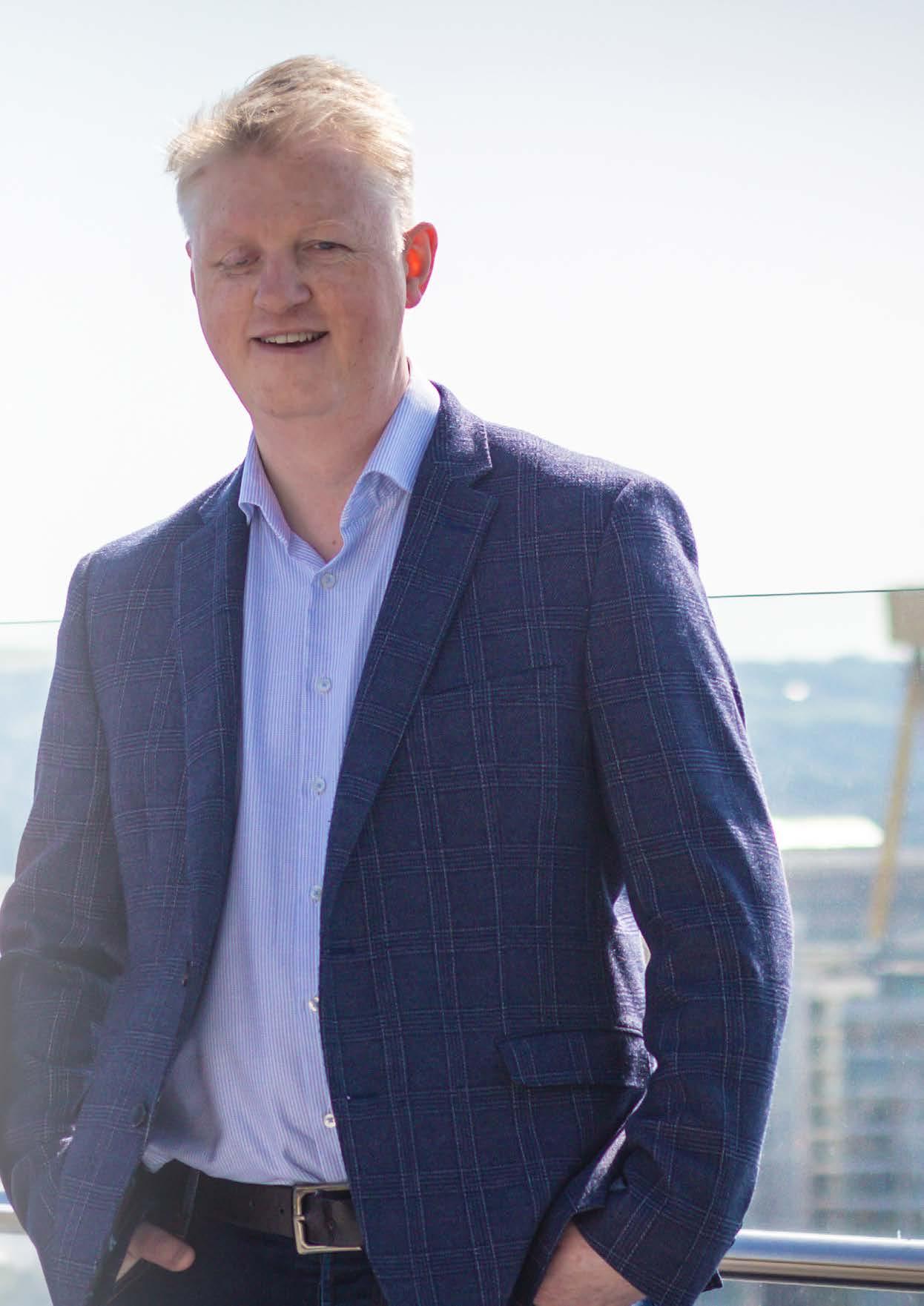
With new offices and a hybrid-first approach, Belfast-based Rapid7 uncover the effort they’re making to encourage a collaborative and creative company culture
Rapid7 is on a mission to create a secure digital world for all. With a global team, they are committed to protecting organisations around the world facing increasingly sophisticated and complex cyber attacks while providing employees with an opportunity to build a career doing something that matters.
As a hybrid-first company, Rapid7 understands the importance of providing their teams with cutting-edge tools and spaces that foster creativity and collaboration across a globally distributed workforce.
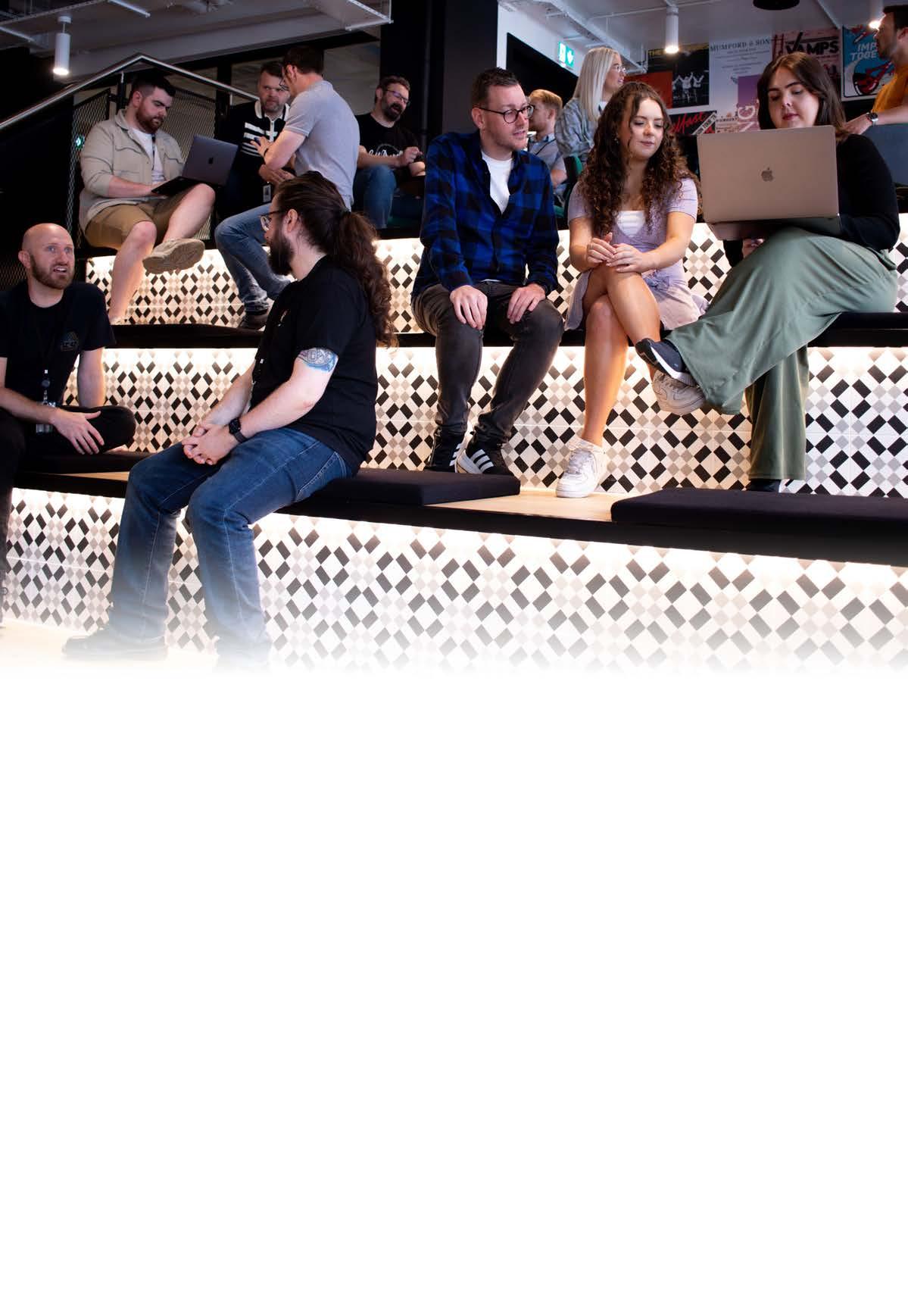
The company’s next-generation office in Belfast was purposely designed to create the best possible environment to stimulate innovation and collaboration resulting in arguably one of the most productive, exciting
and motivating workplaces in Belfast. Located in the heart of the city, this creative office space spans over eight floors, offering a mix of central spaces where people work together to solve customer challenges, quiet areas - including their very own library - for independent thought work, and two cafe spaces for more informal meetups.
In addition to the array of workspaces, the Rapid7 Belfast office provides areas for employees to take breaks and spend time with other team members, including a games room, state-of-the-art gym and exercise studio, and a creative space with 3D printers.
We spoke with a few employees to understand the work they do at Rapid7 and understand how they best utilise the office space.

q As a lead software engineer, what would you consider to be the main attributes of good software? From a lead perspective, it definitely needs to be very testable. Everything we do at Rapid7 is around making sure everything is testable and nothing goes out without a proper unit test in place. So what that means is that if somebody changes a piece of software down the line we have this raft of tests that we can just run and say, okay, it still works as expected from before, including whatever new things we've added on top of it. Secondly, I would have to say simplicity is a crucial attribute. Yes, things can be complicated but you should be able to break it down so you can explain to a non-technical audience.
q It is said that good software engineers need to have good coding and algorithm skills. What other skills and qualities do you look for in your team?
Communication definitely is the main one, especially at Rapid7 where we pride ourselves on having great communication across the entire business. For example, every day I typically have a stand-up with my team which involves a simple 15 minutes to share what we have done, what we plan to do and if there are any blockers that we need to remove. We go around the team and through that communication, we know exactly where everybody is and what we need to put in place to help everyone reach their goals. The most important thing is that they are communicating effectively and if anything is going wrong we can identify the issue and are able to move quickly to rectify it.
q What is something that you've worked on, which has impacted a Rapid7 customer?
Actually, two things immediately come to mind related to the importance of
simplicity and making processes more efficient.
On a recent project, we looked at a product we had that would do a rescan of a website and bring back any vulnerabilities using a public API. By tweaking the API, it allowed us to automate the system and inform the client once the scan was complete so they could examine the results which eliminated the need for manual API calls.
reason someone is working from home on a particular day, we still have the ability to share screens and have whiteboards online so we can Zoom call and still be collaborative. In practical terms, everything is built to be userfriendly and ergonomic for the individual so there are standing desks and another simple but effective feature is that in each of the desks, all of the drawers pull out to make soft seating areas for anyone to sit down beside you and talk over a screen. It’s the simple things like
Another ongoing project we are working on at the moment will bring three separate systems together into one cohesive view so customers can immediately tell how vulnerable their product actually is. From the preliminary feedback we're getting from customers, this is exactly what they want.
q How do your team use Rapid7's innovative office spaces to achieve great collaboration opportunities?

All our rooms, big and small, are kitted out with whatever tech or amenities we could ever need whether that’s wireless connectivity, TVs and whiteboards. Regardless whether it’s a one-to-one meeting or a bigger team meeting, you grab any size of room and it will have everything you need. If for whatever
that just make collaboration so much easier.
q Rapid7 offices are obviously designed to be much more than just a workspace. What are your favourite parts?
For me, the kitchen and dining area are good just to get away as a dedicated space for just eating and chatting away. I always make sure I spend my lunch hour there and avoid eating at my desk. I've worked at previous companies that didn't have that real dedicated area and it meant eating at your desk, so it's just really good to have that disconnect. We have other incredible spaces like the coffee bar, library, games room and even a gym so you can work and relax in the same building.

q What inspired you to study interactive design at University and has working as a UX designer measured up to your expectations?
I've always been creative and I also really liked the process-driven subjects in school and so I wanted something that combined creativity and technology. I’m someone who is fascinated by the human brain and how humans work in terms of psychology, sociology and anthropology and UX typically combines all of those aspects. We need to understand how people interact with the user interface and make those user interfaces work optimally to help them do their jobs well and make their life a little bit easier. If we look at Cyber security professionals as an example, they are typically underresourced and work in a highly stressful environment, preparing for the next big attack, so it’s simple things like, "this process should take me five minutes but because your user interface is set up in such a way it actually takes me 10 minutes". For one task, just losing five minutes of their time each day obviously adds up in the long term.
People can have a false expectation of UX, as they might think it's just about what it looks like but actually it's very much about how it works and how it helps solve the problem that they're facing. For me, I particularly enjoy how UX is about collaborative working with the engineering teams, product managers, our customer specialists and InfoSec teams. By working with our customers and talking to them about what they're trying to achieve, then distilling that down into tasks, workflows and user experience canvases we can then process all of this into a set workflow that they can achieve in the interface itself.
q What are the main drivers for innovation in UX design today?
I think empathy-driven design has been steadily growing within the UX community for a while now. Whether it’s someone simply wanting to buy a pair of shoes or designing a user interface to support a cyber security specialist, you need to understand the entire process to enable them to complete their task. Empathy really helps focus your designs and workflows to help them get what they need done efficiently and with the minimum amount of stress.
collaboration and creativity within your team?

UX is very collaborative across multiple teams in Rapid7 so we are very fortunate to have lots of whiteboards and spaces to stand around and draw out all the different flows, screens and components that we need to build in order to fix each problem we're trying to solve. We have so many different places where we can brainstorm really easily, with huge team spaces and big meeting rooms so all of your team can sit talking
q Can you share an example that changed how a Rapid7 customer uses your products?
I'm currently working on one of our cornerstone products on the console transformation project for over 8000 of our clients and upgrading our tech stack while improving the user experience at the same time; the customer feedback has been incredibly positive. During post-release and in usability testing sessions, we showed the current experience alongside the new experience that we're implementing. It was simple things they pointed out like "I used to have to do a five-step process to make this work and now it's just a simple click of button that saves me hours every day". It’s always very satisfying to see how much we help our customers and we will continue to see that even more as the project develops.
q How does this new Rapid7 innovative workspace help with
while not disturbing anyone else. There's lots of other smaller private spaces too or if you prefer, you can meet in the café, have a coffee and talk in a relaxed environment which is great.
q Rapid7 offices are designed to be much more than just a workspace. What are your favorite spaces?
I think a lot of people would probably say the games room and I like that if you're stuck in a problem, you can go off, play a game of pool then you come back with fresh eyes to your work. Personally, the space I appreciate most right now is a large private room where all the women in the office sit in a circle for a meeting every two weeks called ‘Girl Talk’. It could be something like "what's something that people assume about you that isn't true" and everyone gets to say their piece. It's a good way to build community as you learn a lot from other people and at the same time make really good friendships.

Russell begins by explaining how creativity is at the core of innovation, but creativity with constraints particularly as one of the challenges with innovation is ‘ideation without realisation’.
So how does a company like ESO harness this creativity to generate great ideas and then make them happen? It all starts with design-led processes internally and extensive UX user research but there still comes a point in time where it's not just about the great ideas, it's about making those ideas happen and Russell and Carole have created an ideal environment across the business to enable this.
For ESO, the process begins with thinking about the people and creating the constraints, but also creating the space for them to think. It’s about getting the balance absolutely right to avoid being too constrained with innovation while not being too free-flowing whereby too much creativity comes in.
The offices and working environment were a product of careful design thinking and the UX team was instrumental in building out the space to stimulate creativity and deliver innovation. An enormous amount of thought has gone into the different spaces that exist throughout the building, how they work, and how people flow through them to create the desired employee experience from the second they walk in the door.
There are breakout spaces, collaboration areas, multi-use rooms and even an outdoor green space deliberately installed to give the sense of being in nature to stimulate innovative thinking in a relaxed environment. The entire fabric of the building was purposely designed during the fit-out to spark creativity. Walls feature illustrations including Disney quotes as well as famous medical inventions that have been created in Ireland including the portable defibrillator, radiotherapy and the hypodermic syringe. While these may be less widely
known than inventions like the Titanic, the DeLorean, ejector seats and VTOL aircraft, their impact on the world beyond our little island is clear to see.
Russell points out that ultimately it was innovation that created ESO 19 years ago at a time when everything was being written down on paper by Paramedics and the simple transition of moving that to capturing data in a tablet was a quantum leap at that point in time. Fast forward to today and ESO are now generating millions of data records and the significant trends that can be found in that data. The positive outcomes that come about from that research being published are all because 19 years ago, something quite simple about how to capture that data came about. Paramedics fundamentally need to save lives and they will do that better when they're better informed and making sure that the documentation of what happened is as simple and seamless as possible. Those innovations have been critical to saving lives and improving the health and safety of communities through the power of data.
Innovation at ESO is continuous, about removing barriers and questioning why something cannot happen. These are the drivers that will create the next quantum leap for ESO who are currently developing the next generation of services.
For commercial reasons Russell obviously has to keep those cards close to his chest however in general terms he was happy to talk about the future of innovation in healthcare and comment on recent announcements, such as Apple's Vision Pro mixedreality headset. He goes on to say ‘I think about what that would mean for a paramedic in the back of an ambulance, giving care to patients, what information and telemetrics would be useful for them to see without having to look at a cardiac monitor…. Then I think about other innovations around speech-
to-text to overcome transcription and now we're seeing some agencies in the US innovating with the likes of ChatGPT to edit and produce narratives quicker than ever. We're always mindful of and constantly thinking about how and when new ideas and innovations can come into our particular sphere’
ESO has a reputation for innovating technology and providing the ideal environment for creativity to flourish and their Senior People Experience Manager Carole is committed to ensuring that this also extends to the entire people experience within the business itself. The fundamental pillars for this are based on communication and shared goals with systems being in place to enable employees by removing any blockers in their day-to-day work and develop their careers within the business.
ESO’s strategy for all the employees is straightforward: ‘Our ultimate goal is to make ESO the number one place for our people to grow their career, while living out their purpose’.
This involves close collaboration with all the employees to deliver a consistent approach whereby individual and shared goals all roll back up into the company goals and how everybody can play a role in that. Communication and transparency through regular one-to-ones, quarterly check-ins and goal-setting sessions all contribute to creating an environment whereby everyone understands the company goals and can see how their own goals play into that. This all happens in real time and by capturing those conversations with people to see how they're feeling about their growth, their wellbeing, how their work is going and what blockers they are having so that the entire business moves forward together. Carole explained how this has already had a hugely positive effect on employees because now every single person, in every part of the organisation, can see and understand
that what they are doing is impacting on the overall success of the business.
Carole explains the importance of every individual’s involvement in goal setting. ‘It's absolutely crucial that everyone is involved in goal setting, there's absolutely no point in just rolling goals out without an employee being involved in their creation. If you involve someone in setting their goals, then they feel a sense of belonging, ownership and accountability. When you have those elements, there is more likely to be success in achieving those goals’
While everybody in the company has the ability to set and own their goals, no one else can edit these goals and everybody in the company has access to view everyone else’s goals. This was done purposefully, to provide complete transparency and also the ability to help support each other to attain their goals.
Russell and Carole both make the point that technology in itself is not innovation but rather it's all about the people and how their values are aligned with ESO’s engineering principles.
As Russell explains ‘Done is better than perfect. We are not looking for perfection, it's about what we know now and how do we get this done so we can improve. Acumen and teamwork are really important to us so we are actively embracing a culture of learn-it-all’s not know-it-all’s’
This approach leads to incremental improvement over time by taking hypotheses, testing them out and then responding to those hypotheses. So that's how you know that your innovation is moving in the right direction, as opposed to just trying lots of things and not knowing what sticks. For ESO, this translates simply into having the right type of people, in the right mindset and with the right culture, evnironment and the support mechanisms in place to make it all happen.
In 2021 following Covid, after a phased return to working in their offices again, Kainos moved to a new hybrid way of working. This heightened the need to review how they used the office from both a cultural and physical perspective.

While they were starting to slowly open offices back up, they started a process of consultation with their people. Through this feedback they discovered that one of the main reasons that people came into the office was to collaborate and meet with friends and colleagues. This, in turn was one of the drivers in designing their new spaces. They wanted to give their people greater flexibility about their work location, taking into consideration their own needs, those of their role, team and customers.
With growth continuing across the globe Kainos created an office blueprint model based on this feedback that they could roll out across their offices globally. Colette said, “We wanted to create an amazing experience for both colleagues and visitors, a unique place that respects local culture yet expresses its global presence underpinning the Kainos values of co-operative, creative, respectful, honesty and determined. We based our design on four main principles; welcome, work, collaborative and social.”
We sat down with Colette Kidd, Chief People Officer, to hear all about how the plans for this new space came to fruition. She also talked to us about their new employee engagement strategy and how this is making many positive changes throughout the business
The new workspaces have been purposefully designed to support the diverse needs of staff to enable them to work to their full potential. This includes quiet spaces, presentation spaces, formal and informal meeting spaces, as well as prayer rooms, quiet spaces and wellbeing areas.
Colette stated, “Our spaces enable our people to collaborate with each other whether that is in small groups of 1 or 2 people or larger dispersed groups of employees across the globe. Our redesigned offices support every eventuality and have the technology in place to enable this to happen.”
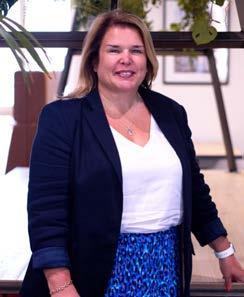
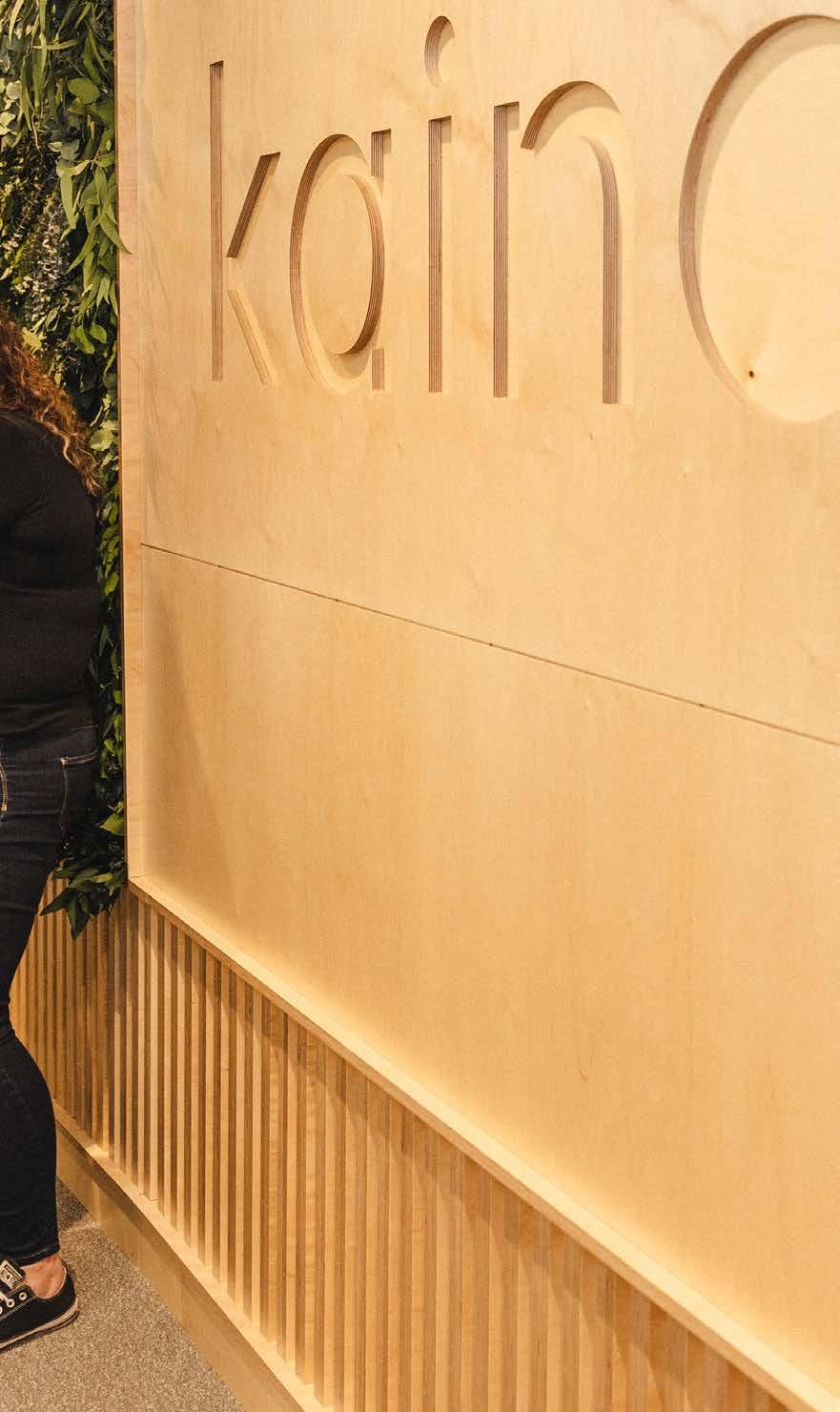
To create that warm welcome each office exudes the same look and feel starting from reception and extending throughout the entire office. As a result, all staff and visitors are greeted by the front-of-house team who exemplify Kainos’ unique culture immediately as soon as you step through the front door.
The importance of collaboration is self-evident and breakout spaces have been created to allow a place for teams to get together,
share knowledge and innovate. These spaces all have interactive technology to enable cross-team communication which is essential given Kainos’ teams operate worldwide.
Finally, to promote social connections there are entertainment and breakout spaces to encourage social interaction. Informal chat areas were intentionally included, with coffee shopstyle booths to provide a relaxing environment to have fun with colleagues.


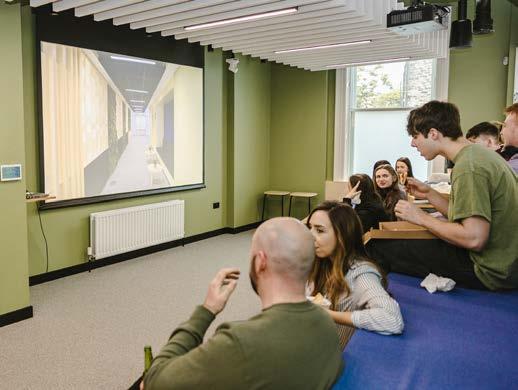
But, Kainos aren’t just stopping here, Colette stated, “Our ambition is to create sustainable workspaces that will promote and support our values and the diverse needs of our workforce. We want to enable our people to become more connected socially with their work colleagues.”
Kainos is the perfect example of how a company can effectively use employee feedback to create a wonderful place to work by listening to their employees' needs, concerns, and suggestions. Previously undertaken annually, at the start of this year, they made headway with this by implementing a new employee feedback tool, Peakon, that sends a monthly survey to all employees across the globe. Colette stated “After much research, we introduced Peakon to the company which is an intelligent listening platform that allows us to anonymously capture employee feedback about how we can improve the employee experience at Kainos. Peakon gives our people the chance to provide their honest opinion
confidentially and regularly, so we can drive change and help build a better workplace”.
Colette stresses how important it is to respond to their employees’ needs, not just for them but for their customers and for the overall good of the company. “Peakon gives our people the chance to provide their honest opinion confidentially
leave was also re-evaluated, with maternity and adoption leave being increased to allow employees to spend more time with their families when it is most needed.
Colette says that communication is key in supporting Kainos’ values of honesty and respect. “We believe in being open and honest with people as we understand that how we communicate feeds into how people perceive our culture as an employer. I consider this an ongoing process as improving our communication is never complete, it’s something we must continue to work at.”
and regularly, so they can drive change and help build a better workplace.”
Many innovative ideas have been born out of this feedback and Colette is in no doubt there will be many more to come. “Our office blueprint was a direct result of employee feedback, and we also have introduced new policies such as our menopause policy, our reasonable adjustments policy and made amendments to other policies thanks to suggestions from our people.”
As a result, a global benefits review was conducted resulting in private medical insurance and group income protection being provided to everyone at Kainos from day one of employment. Family
Kainos operates on a global scale and are the most diverse they have ever been in their entire history, so actively listening to their people and acting on that feedback is vital to their operations. Colette stated, “We want our people to be proud to work for a company that protects the planet, celebrates diversity and creates a sense of community across our global workforce.”
It is clear that Kainos value the happiness and wellbeing of their people and are committed to providing an environment that sparks creativity and fosters teamwork. They are working through a phased refurbishment of their offices, with Birmingham and Belfast now complete they plan to complete their Indianapolis space in August, with Toronto and Gdansk completing in November.
Professor John Goodacre, DSbD Programme Director, highlights how leaders in the industry are planning to combat challenges of security in cyber
The escalating costs of cybercrime, which now reach trillions of dollars annually, have propelled the need for more secure technology solutions.
As the global software landscape expands, so does the attack surface, highlighting the vulnerabilities that arise from the design, construction, and usage of technology. It has become evident that current cybersecurity practices are insufficient in dealing with these attacks. To combat this, a fundamental shift in technology is required to block exploitations, limit data loss, and mitigate the impact of ransomware attacks so as to reduce the unsustainability of today’s cybersecurity response. In this context, NCSC’s Cyber UK 2023 event went to Belfast as a leading UK region in cybersecurity. They brought ahead the issue of securing an open and resilient digital future to the forefront of this years agenda.

Recognising the need for transformative action, the NCSC emphasised the importance of addressing the fundamental technology and "securing foundations
for technology advantage" during Cyber UK 2023. To achieve this, the UK Research and Innovation's Digital Security by Design (DSbD) programme has been fostering collaboration between industry, academia, and the government to develop a solution. DSbD is working to create and enable a new, more secure architecture capable of overcoming the challenges hindering the growth of the digital world. Notably, the technology being developed through DSbD funding has the potential to prevent approximately 70% of ongoing vulnerabilities while providing developers with new, more efficient approaches to their work.
At Cyber UK 2023, leading technology companies Google and Microsoft put aside their commercial differences to join forces on stage and underscore their engagement and investment in the DSbD programme. The session highlighted the significance of the CHERI technology from the University of Cambridge and emphasised the need to continue building on the existing ecosystem. This unity and collaboration among industry giants demonstrated the immense
potential and importance of secure technology in creating a safer digital landscape for all.
Cyber UK 2023 concluded with a resounding call to action from the NCSC, urging all technology users and supply chain stakeholders to demand more secure technology. During the final plenary session, Dave Harcourt from BT encapsulated this sentiment by stating, "Surely we all want to live in a world with 70% fewer vulnerabilities. Let's all demand it and start the ball rolling!" This rallying cry signifies a crucial turning point where the industry and its participants must unite to drive the development and implementation of secure technology.
It is not too late for organisations to join the growing ecosystem and contribute to the advancement of secure
technology. Northern Ireland-based companies, such as Pytilia and Ampliphae, have already taken the lead by requesting a Morello Board from www. DSbD.tech. By doing so, they are exploring the potential benefits this technology can offer and actively participating in the development of the ecosystem, preparing themselves for future commercial opportunities.
The urgent need for more secure technology has become undeniable in the face of escalating cyber threats and their exorbitant costs. The NCSC's call to action at Cyber UK 2023, supported by leading industry players like Google and Microsoft, highlights the necessity for transformative change in technology design and implementation. The DSbD programme is paving the way for a new era of security by creating a more secure architecture that can significantly reduce vulnerabilities and enhance productivity. It is now up to all stakeholders to demand secure technology and actively contribute to the development of a safer digital future.
For more information on DSbD and its initiatives, visit www.dsbd.tech
Clare Guinness, Innovation District Director at Belfast City Council, speaks about some of the upcoming projects being developed here, as well as why it’s essential for Belfast to strive for net zero
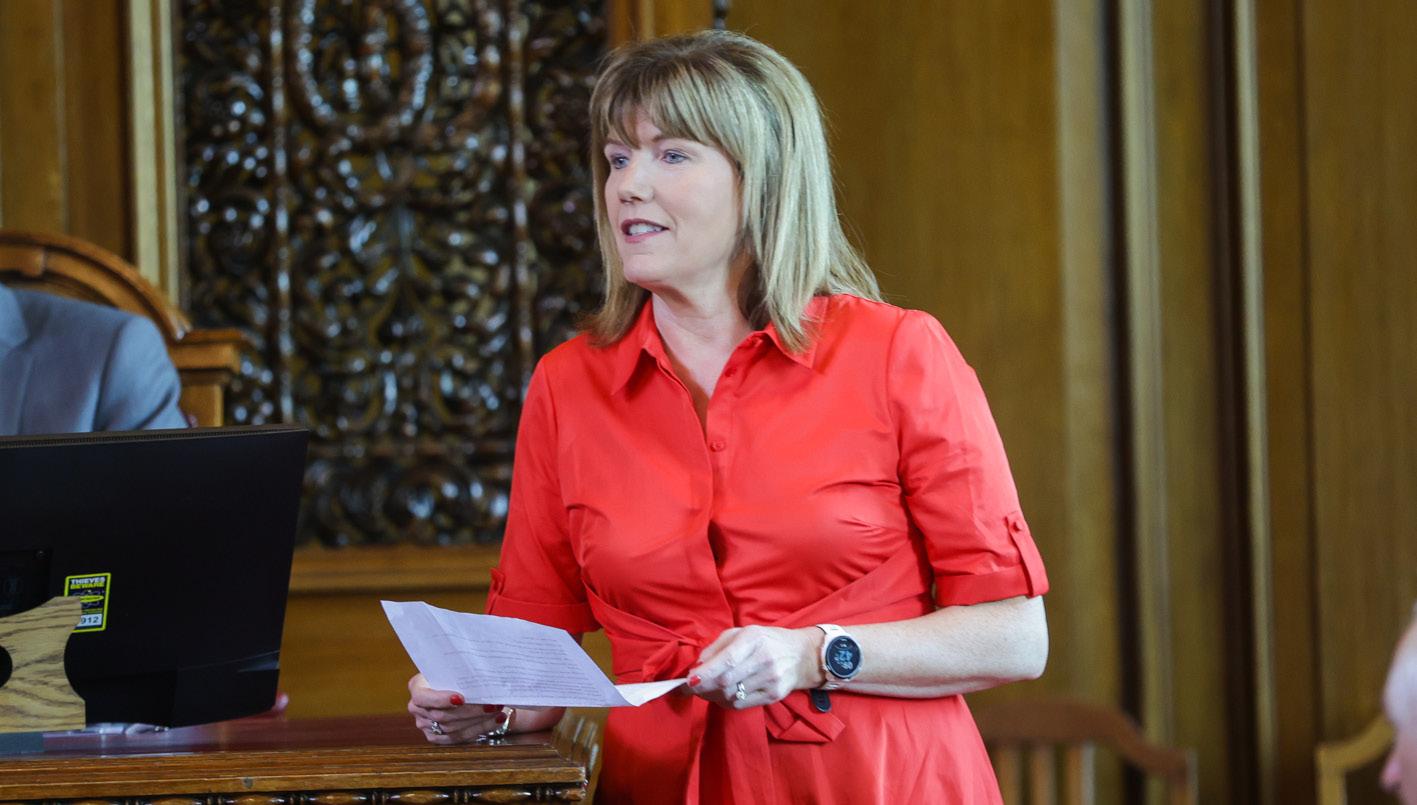
Not a minute before time, the five innovation projects in the Belfast Region City Deal programme of investment are coming to life.
Some, like Studio Ulster at the Giant’s Park in Belfast’s North Foreshore, are already in construction, and others are coming very close to that important milestone. Whilst there’s been a long germination period, remember, we are still very much at the foothills in respect of realising their full value and potential in economic terms.
Doing so will require attracting private investment and building muchneeded revenue streams. Some of the additional capability is being added ahead of the buildings themselves,
allowing us to forward sell the opportunities. For instance, Ulster University has already constructed a mini virtual production facility to showcase some of the technology that Studio Ulster will introduce at scale.
Selling and business development skills are now just as important as the tech and digital skills underpinning these flagship projects. We need sales pitches that are precise and targeted towards those industries who not only require the capability, but also have the R&D budgets available to invest with our universities to unlock the financial returns. Drawing out the complementarity between the City Deals also requires careful consideration and targeting.
However, being considered does not equate to being slow – lead times require us to act and act swiftly, so that we can identify demand, stimulate interest and start to build a pipeline in this development stage - so that when the centres are complete, they are well on the way to operating at capacity. The ultimate validation for any product or service lies in the market’s propensity to pay for it.
Digital Catapult appears to be in the final stages of having the muchanticipated Design Smarter Digital Twin approved. This development has the backing of both City Deals and private capital from several other parties. It will bring terrific additional capability, making multiple crosssectoral applications beyond high value
manufacturing and transport possible.
Being a non-techie, there are times I find this world of new technology super complex –and downright baffling.
Put simply, some of our tech capability is specific to particular uses and sectors, while others have multiple applications.
Specific might be digital biomarkers to identify early who might benefit from curative cancer treatment, whereas agnostic might be something like software engineering - which is just as applicable to FinTech as it is to MedTech. The distinction is particularly useful in a place of our scale, as we clearly want to open as many doors as we can with a discrete number of true strengths.
We must be agile in utilising and combining our strengths to gain maximum impact, rather than focusing too much on aligning sectors with capability. Much of our capability in cyber, AI, engineering, and data analytics have cross sectoral application.
City Deals and Digital Twin aside, there are a few specific initiatives where we need to grasp the nettle.
One of the single biggest challenges Belfast faces over the next decade is achieving net zero. Carbon budgeting has started, and commitments have been
made. Belfast’s share of the global carbon budget is 14m tonnes until 2050. With a run rate of 1.5m tonnes per annum, the budget will be exhausted by 2030. To remain competitive, we must act to decarbonise our city, otherwise we risk being a carbonised black dot on a green investment map of the future.
There are strategies and hopefully soon there will be more policies on the topic, but it’s implementation initiatives that will actually make it happen.
Plans to create a Net Zero Tech Park in Titanic Quarter is one such initiative that could make a big impact on both our economy and our environment.
Titanic Quarter is already home to Queen’s University Belfast research centres, Titanic Exhibition Centre, SSE Arena, Belfast Met, Catalyst and the Titanic Hotel. It is close to the port, the airport and the city centre. Greentech companies like Catagen and Artemis Technologies are based there, as well as some major industrial giants like Harland & Wolff and Spirit Aero.
There are people living there too and many more residents to come, with the build of Loft Lines (778 private, affordable and social homes) underway. Titanic Quarter has numerous advantages, not least a substantial waterfront and a rich maritime heritage - but it has even more than that! Most of this area is under the sole control of Belfast
Harbour Commissioners, making it the perfect place to test and demonstrate new (green) technology. The roads, the pavements and much of the real estate has a single landlord.
That was part of the reason why Artemis Technologies relocated here. This single ownership and control also helped to secure the recent Innovate UK autonomous vehicle trial (Project Harlander). This multiplicity of uses brings national complexity to a micro geography and is unique in a UK context.
We have the potential to become a truly global hub – a living lab where green products are designed, demonstrated, tested, and manufactured. Working with key stakeholders including Belfast Harbour, Titanic Quarter, Queen’s University, Ulster University, Belfast Met, Artemis Technologies and Catagen, we are establishing how best to make this area a pioneering place for the green economy – to not only decarbonise Titanic Quarter, but also to grow NI’s green economy and attract investment via “green-shoring”. This isn’t just an economic imperative, it’s social and moral too.
Creating jobs in the green economy, and providing sources of sustainable, affordable energy will be hugely beneficial for our citizens and our industry. Titanic Quarter’s success could be replicated across the rest of NI and beyond. It’s of course not all about
Belfast, but we do need to recognise it as the economic driver for the region with 50% of the business base and 63% of employment.
Supporting our manufacturers to reduce carbon throughout their supply chain would see the Net Zero Tech Park positively impact all Northern Ireland and democratise the deep tech capability for SMEs who are the backbone of our economy. Helping to grow indigenous companies, whilst continuing to attract scale through targeted FDI would see the Net Zero Tech Park become a catalyst for prosperity, improve our planet and create opportunities for our people.
From an economic perspective, NI being the gateway to GB and European markets is a huge advantage. Commercially, speed to market will always be a major determining factor in returns achieved. Add to that securing the investment zone designation - which was announced in the last budget - and you start to see how the NI plc pitch is becoming even more compelling. Restoration of the Assembly is a prerequisite of delivery and success.
In closing, a nod to one of our great literary innovators, George Bernard Shaw: “The people who get on in this world are the people who get up and look for the circumstances they want, and, if they can't find them, make them.” …The time to act is now.
FirstUp established their new Technology Centre in Belfast in 2019 and have just recently announced further plans to expand its workforce.
The Silicon Valley-based software firm creates technology that allows companies to communicate with their employees across all devices with targeted, relevant news, information and updates and its software is used by more than 40 percent of Fortune 100 companies.
FirstUp’s River House offices in the City Centre afford wonderful views across Belfast, a City that has historically been a global hub for innovation and the ideal backdrop to explore what innovation looks like within the company itself and what it means to Mark personally.
Mark starts the conversation by explaining that innovation is a critical part of FirstUp’s offering within Northern Ireland, so much so that all his teams are empowered to make use of 10% of their time for innovative purposes. This typically includes investing time to research and review innovative technologies and obviously more and more this means expanding AI capabilities. According to Mark, this approach has paid dividends and his people have shown great aptitude and have been able to really buy in, delivering things that have been hugely impactful for the business.
On a personal level, Mark has benefitted from exposure to a number of forms of innovation through the years. He recounts a number of approaches including product ideation and conceptualising unique problems with disparate user groups prior to applying innovative technical solutions. However, the core part of innovation that has always remained central to Mark is that innovation needs to be valuable for the business it's taking place in. The real sweet spot for innovation for Mark is having a business problem that he can apply a different solution, to be innovative and apply new technologies to solve that business problem. It’s all about understanding the fundamentals, whether the solution is both desirable and feasible as well as scalable to serve the needs of the business. As Mark states ‘’While Innovation itself is a hugely powerful thing, the practical application of innovation is where the value is and that's why we must make sure that we really benefit from the types of solutions we can achieve’’.
We asked Mark about the importance of environment for

driving creativity and inspiring new ideas and for him there are two critical aspects to this. Firstly, the physical environment is all about ensuring the company offices are optimised for collaboration and secondly in the virtual environment, when working remotely, everyone has the right tools available to use in order to share ideas and work on the same solutions together. This means being able to work asynchronously if required with teams in the US offices or other partners across the world. So the ideal environment means not only having first-class local offices but also being supported by global capabilities while working remotely is a hugely important thing.
Coupled with the correct environment, the culture of innovation within the business clearly thrives when people are open and will freely listen to ideas that offer the ability to approach a problem differently or are happy to prototype solutions to learn more about the problem space. Continuous Innovation is ever present and recently the company ran an AI-focused hackathon, specifically focusing on large language models and Chat GPT. All the engineering teams were given a week and the freedom to work on a solution that they thought would add value to the business.
As pioneers of intelligent communications for the workforce, FirstUp is positioned at the forefront of the AI revolution. FirstUp believes that AI is a transformational business accelerator, which is why we’re excited to announce CommunicationAI, powered by GenAI.
By coupling insights from large language models (LLMs) with employee engagement data that flows through our intelligent communication platform, CommunicationAI will offer communicators streamlined productivity capabilities specifically
designed to elevate the employee experience.

With powerful capabilities like generative content, predictions, and automation, CommunicationAI is a must-have capability for communicators, HR, and IT leaders, as well as employees who now have an AI-enabled interface to request and access information.
CommunicationAI empowers communicators to deliver personalized, relevant, and engaging experiences across every employee moment with generative AI and trusted employee data with the ability to:
q Improve content quality and relevance with ContentAI, which generates high-quality text, subject lines, visuals, summaries, and customizable templates, in addition to recommendations for tone and style based on employee attributes.
q Deliver hyper-personalized employee experiences with EngageAI, which automatically analyzes behaviour data and creates audience segments to predict the best journey along with format, channel, time, and tone for the highest level of engagement.
q Gain insights faster and easier with Workforce Intelligence by using natural language prompts to learn exactly how your campaigns are doing in relation to your employee segments (and ask for trends and predictors) without digging for the data.
q Quickly provide employees answers with a Digital Assistant, which empowers employees to get real-time answers across multiple systems without using complex queries. Digital Assistant goes beyond traditional keyword matching, diving deep into the meaning and context of each query to deliver personalized access to what employees need when they need it.

Tim first established the Intelligent Automation practice at EY in 2016 at a time when automation was primarily focused on Robotic Process Automation (RPA); however, over the last number of years, this space has evolved massively.
From automating low-complexity tasks as a tactical solution or as a lever to gain efficiencies within a business, recent software enhancements and tools available today have resulted in a quantum shift forward for all organisations globally. These new developments range from low code / no code solutions and chatbots, to highly complex AI-enabled solutions leveraging chatGPT and openAI. By incorporating these tools, the practice can innovate in ways that were
simply not possible to achieve in the past.
Tim explained that leveraging intelligent automation as a means to innovate typically starts with careful consideration of the full ecosystem of the organisation, however before all of that, the first step is to understand a client’s business problem or challenge and only then can you consider what the right technology is and if it will deliver the desired business value. An organisation will often leverage automation as an enabler to try and introduce and encourage the adoption of innovative ways of working, so when starting out on the automation journey, often it is the back office enabling functions such as finance, payroll and HR that deliver the quickest return on investment. It’s exactly these high-value
use cases that are typically the catalyst for companies to get started and then build momentum using this as a lever, in order to progress and achieve greater benefits by adopting some of the more complex technologies.
Tim has worked with organisations across both the public and private sector, in a wide range of industries. Over the last number of years, he cites some of the amazing use cases delivered for some of his clients: q Life Science: Uploading documentation to the eTMF, analysing results from clinical trials
q Utilities: Regulatory changes impacting vulnerable customers, pricing changes
q Banking: New customer applications, switching bank accounts, contact centre optimisation
What might have initially started as an internal focus soon becomes externally focused in terms of improving the customer experience by enabling them to get accurate information faster and quicker, suppliers get more transparency and C-suite executives can get access to data in real-time.
Given the current climate where more and more daily tasks are becoming automated, we talked about whether it was actually possible or viable for every process to be automated and what the likely exceptions might be. Tim’s response was unequivocal, explaining how ultimately everything is premised on the business problem that you're trying to solve. ‘’The short answer is no. I would always say there's no benefit in automating a bad process - if it's a bad process, then it needs to be standardised and optimised to a certain extent first before it could be considered as a suitable use case for automation.’’
The key to successfully implementing intelligent automation begins with an audit to formally identify and document all the desired outcomes. By defining the KPIs and principles at the outset,
it's easy to apply these through an assessment process whilst at the same time ensuring bad processes and practices are eliminated. Tim explained how his team at EY have accrued valuable knowledge and developed a wide range of different tools over the years to streamline the assessment process. As a result, these can be easily adopted by different clients to help them identify strong and highvalue use cases for automation. This enables clients to prioritise and select from their backlog-specific processes to take forward into developing for automation. This also includes ensuring that the right technology is also applied, and with the democratisation of AI for example, previous barriers to entry to some of the more complex automation technologies have now been removed allowing organisations to harness them.
Tim leads a diverse team across the Island of Ireland, emphasising that the key to a successful workforce is the people. “EY invests a huge amount into Learning & Development, and it plays a large part in our success as a practice. Having such a diverse workforce encourages collaboration, better ideas and generally a culture that harnesses innovation.” There is no doubt that EY have taken huge strides since launching their Intelligent Automation practice and the industry is clearly evolving rapidly at pace. Tim recently attended an event with one of his alliance partners who were able to demonstrate the latest enhancements to their suite of products and provide a few insights into the future of Intelligent Automation. As he explained ‘’Intelligent Automation is no longer just about simply automating tasks, but instead, it’s very much seen as a platform to drive digital transformation, right from ideation through to process mining, while simultaneously tracking and measuring the benefits of each task and process in real-time while in production.’’
New enhancements enable automation tools and software to integrate with
other core systems across a technology landscape, as well as off-the-shelf third-party SAAS applications on their tech stack. The ability to integrate easily is clearly driving the adoption of the technologies and ultimately unlocking their true potential and value for organisations. In terms of innovation, technology is only one part of it and Tim believes it’s people who are the key to driving the transformation. While new technologies in terms of their versatility and their usability have really opened doors by creating new opportunities, it’s advancements, particularly in some of the citizen-led development tools, that are driving the curiosity to really challenge the status quo around automation.
Looking at current trends, we are likely to see much more innovation around AI. While Artificial Intelligence has been around for a long time, the pace at which it has evolved has been staggering, particularly with the likes of ChatGPT. Specifically, Generative AI or large language modelling tools that are really capturing the world's imagination. ChatGPT for example, isn’t just limited to specific missions but it's more of a general AI tool that has a purposebuilt chatbot in the background, so rather than just be seen as a tool for automated conversations, it can ultimately use those conversations to build out and automate numerous tasks.
For Tim, the convergence between all of these different tools across the automation spectrum is driving a real shift in terms of the mindset of his clients. ‘’There is a real demand in the market to really challenge and think about how we can bring all those kinds of technologies together, to really enhance and improve both the customer experience, as well as the employee experience. Ultimately, automated intelligence is a key driver to unlock potential and continue to be a catalyst to really drive innovation more broadly’.”
The world of animation is on the brink of a paradigm shift as Belfast-based, RETìníZE - one of Europe's fastest-growing creative technology companies - prepares to unveil a ground-breaking tool that will revolutionise the way creatives collaborate and produce 3D animations.
Animotive, an immersive real-time animation tool, is scheduled for launch this month. Having recently won the prestigious 'Best Innovation in Animation' award at the Irish Animation Awards 2023 for its collaboration with Flickerpix Animations, Animotive is poised to redefine the animation industry.
By enabling remote collaboration in a virtual space using virtual reality (VR), Animotive empowers users to work together seamlessly, regardless of their physical location.
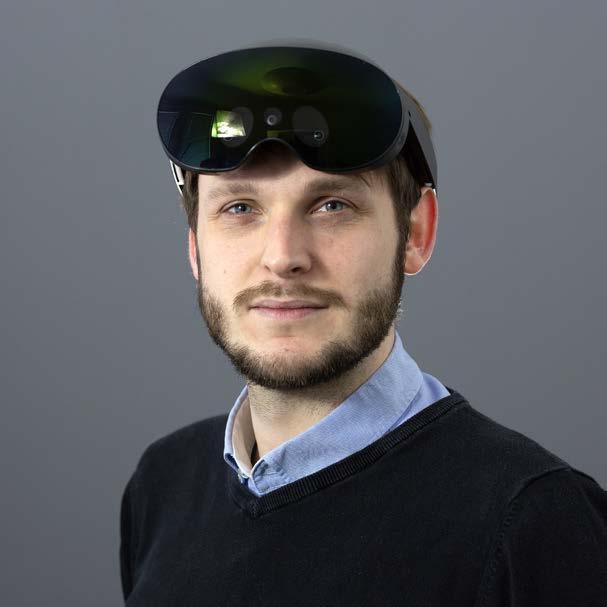
With the ability to embody characters, manipulate lighting, shoot scenes, and export content in real-time, Animotive streamlines the animation production process, offering unprecedented creative freedom, efficiency, and cost savings of up to 80% when compared to traditional workflows.
Some of the world’s largest animation studios are already using Animotive to produce their animated content.
RETìníZE was co-founded by father and son team Phil & Jack Morrow in 2019. Prior to forming RETìníZE, their reputations were built over many decades, producing high-end Global Film & TV.

Jack Morrow, RETìníZE’s CTO, worked as a technical supervisor in the London TV industry, where he became increasingly interested in immersive tech and won a Cannes Golden Dolphin for his VR film for Save the Children.

Phil Morrow reveals how they first came up with the idea for Animotive: “We’ve always loved to stretch our creative and technical frontiers so, a few years back, we set ourselves an impossible challenge: To
take a 3D animation project from script-to-screen in 24 hours. That kick-started a journey that soon became a mission - to revolutionise 3D animation production”
Creating 3D animated content has long been recognised as a complex, costly, and time-consuming endeavour. The intricate nature of the process often requires significant resources, technical expertise, and extensive production timelines. Animotive aims to disrupt
this conventional approach by providing a fast, fun, and affordable solution accessible to creators from all backgrounds.
Phil Morrow, emphasises the need for a transformative tool like Animotive, stating, "Anyone who's tried to create 3D animated content knows that it's complex, costly, and time-consuming. Our goal is to make it fast, fun, and affordable for creators from all backgrounds." By removing the barriers of complexity,
cost, and time, Animotive seeks to empower creators and unlock their true potential.
Animotive introduces a virtual environment that serves as a shared workspace for remote collaboration. Through the power of VR, artists and animators can connect and collaborate as if they were physically present in the same studio. This virtual space provides a dynamic and immersive platform where creators can interact
with scenes, characters, and lighting in real-time.
The real-time capabilities of Animotive are a gamechanger in the animation industry. Animators can instantly visualise the impact of their decisions, making adjustments and refining animations on the fly. This immediate feedback loop fosters a more iterative and organic creative process, resulting in animations that more accurately reflect the artist's vision.
Furthermore, Animotive's intuitive interface and userfriendly features empower creators of all skill levels to unleash their creativity. With its seamless integration of character embodiment, lighting manipulation, scene shooting, and content exporting, Animotive allows artists to focus on their artistic expression rather than technical constraints. This newfound creative freedom fuels innovation, opening doors for captivating storytelling and imaginative animations.
In addition to enhancing creativity, Animotive brings significant cost savings to the table. Traditional animation production workflows often demand expensive hardware, extensive rendering times, and a multitude of specialised software licenses. Animotive disrupts this model by streamlining the process, reducing the need for costly infrastructure, and offering an affordable pricing model.
With cost savings of up to 80% compared to traditional workflows, Animotive democratises the animation industry, making it accessible to creators with varying budgets. This affordability allows independent animators and small studios to compete on a more level playing field with established industry giants. The reduced financial burden also enables creators to allocate resources to other aspects of production, such as storytelling, character development, and marketing.
The accessibility of Animotive is further amplified by its pricing structure. The tool will launch in July 2023 with a free version, enabling aspiring animators to get started without any financial barriers. For more advanced features, pro subscriptions will be available starting from $66.99 per month, making Animotive an attractive option for professionals seeking cutting-edge animation tools.
One of the most significant advantages of Animotive is its ability to facilitate remote collaboration among creatives. In the traditional animation production process, collaboration often requires physical proximity, limiting the ability to work with talent and experts from around the world. Animotive's virtual space eliminates these geographical barriers, enabling artists, animators, directors, and other stakeholders to collaborate
seamlessly in real-time. By connecting individuals from different locations, Animotive enriches the creative process by fostering diverse perspectives and collaboration between talents who may have never had the opportunity to work together otherwise. The tool empowers teams to work concurrently on different aspects of the animation, reducing project timelines and increasing overall efficiency. Whether it's character design, scene setup, or lighting adjustments, the real-time nature of Animotive allows for instant feedback and collaboration, resulting in a more cohesive final product.
Furthermore, Animotive's virtual space offers a unique opportunity for educational institutions and aspiring animators. Through virtual classrooms and tutorials, educators can guide and mentor students remotely, providing hands-on learning experiences that were previously limited to physical classrooms. As well as for teaching animation, Animotive can be used to teach filmmaking, as it is essentially a fully virtualised multi-camera TV studio. Students can collaborate to create short animated films extremely quickly. It can also be used as a teaching tool by other disciplines, such as medicine and psychology, that can utilise its rapid scenario-building capabilities.
The 3D animation industry stands on the precipice of
a transformative era. The introduction of this groundbreaking real-time animation tool promises to reshape the way animations are created, offering unparalleled creative freedom, efficiency, and cost savings. Animotive's ability to enable remote collaboration, streamline workflows, and enhance accessibility marks a turning point in the evolution of animation production.
With its fast, fun, and affordable approach, Animotive empowers creators from all backgrounds to push the boundaries of their imagination and bring their visions to life. The tool's potential extends beyond traditional animation, encompassing applications in film, gaming, advertising, and virtual reality experiences.
The animation industry eagerly anticipates the impact this revolutionary tool will have. RETìníZE's commitment to making animation accessible and enjoyable for creators of all skill levels reflects the company's dedication to fostering innovation and empowering the next generation of animators.
In the not-too-distant future, we can expect to witness a new wave of captivating animations brought to life through Animotive. The tool's ability to revolutionise remote collaboration, unleash creative freedom, and transform the animation production process positions Animotive as a true gamechanger in the industry.
In today's digital age, data security is of paramount importance for organisations in all industries.
With the increasing number of cyber threats and the potential for devastating data breaches, it has become essential for companies to implement robust information security measures. The globally recognised standard that can help companies achieve this is ISO 27001. ISO 27001 is an international standard for information security management systems (ISMS) that provides a systematic approach to managing information security risk. The number of companies certificated to ISO27001 (in over 140 countries) now stands at over 70,000 almost double the number of certificates from 2019.
Here are the main reasons why you should consider implementing ISO27001.
1. Tender Criteria – tenders are increasingly specifying that suppliers must have ISO27001 certification. Suppliers without certification will simplify fall at the first hurdle and will be eliminated from the tender process. The NHS HSCN Compliance Process now states that suppliers must hold in ISO27001 certificate. With the rapidly growing number of ISO27001 certificates, certification to this standard has now become the norm in many sectors from IT to construction.
2. Comprehensive Risk Management: ISO 27001 provides a structured framework for identifying, assessing, and managing information security risks. It ensures that organisations have a thorough understanding of potential threats and vulnerabilities and helps them develop appropriate controls and safeguards. By implementing ISO 27001, companies can proactively address risks, reduce the likelihood
of security incidents, and minimize potential damages.
3. Legal and Regulatory Compliance: Compliance with legal and regulatory requirements is crucial for organisations to avoid penalties, reputational damage, and legal consequences.
ISO 27001 helps companies align their information security practices with relevant laws, regulations, and industry best practices. It demonstrates a commitment to data protection and can facilitate compliance with various regulations such as the European Union's General Data Protection Regulation (GDPR) or the Health Insurance Portability and Accountability Act (HIPAA) in the United States.
4. Enhanced Customer Trust: Data breaches can severely impact an organization's reputation and erode customer trust. By implementing ISO 27001, companies demonstrate their commitment to safeguarding customer information and protecting their privacy. The certification serves as tangible proof of an organization's dedication to information security, making it a valuable asset when attracting new customers, building partnerships, or participating in tenders.
5. Improved Operational Efficiency: ISO 27001 encourages organizations to adopt a systematic approach to information security management. It helps streamline processes, identify areas of improvement, and optimize resource allocation. By implementing ISO 27001, companies can enhance their operational efficiency, and ensure that information security measures are integrated into their day-to-day operations.
6. Competitive Advantage: In today's competitive business landscape, having a robust information security management system can provide a
significant competitive advantage. ISO 27001 certification sets an organization apart from its competitors by demonstrating its commitment to information security and risk management. It can become a key differentiator, particularly in industries where data security is a primary concern, such as finance, healthcare, and technology.
In conclusion, implementing ISO 27001 brings numerous benefits to organisations. It enables comprehensive risk management, ensures compliance with legal and regulatory requirements, enhances customer trust, improves operational efficiency, and provides a competitive advantage. By adopting ISO 27001, companies can establish a strong foundation for information security, protect sensitive data, and mitigate the potential risks associated with cyber threats. In today's datadriven world, investing in ISO 27001 is a strategic decision that can safeguard an organization's future and foster sustainable growth.
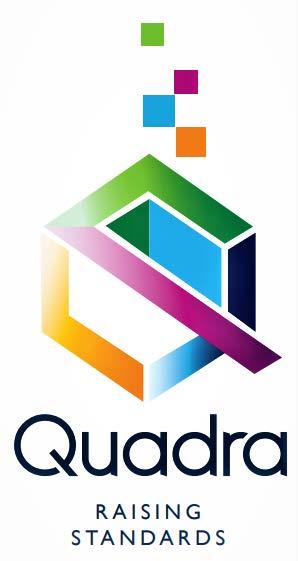
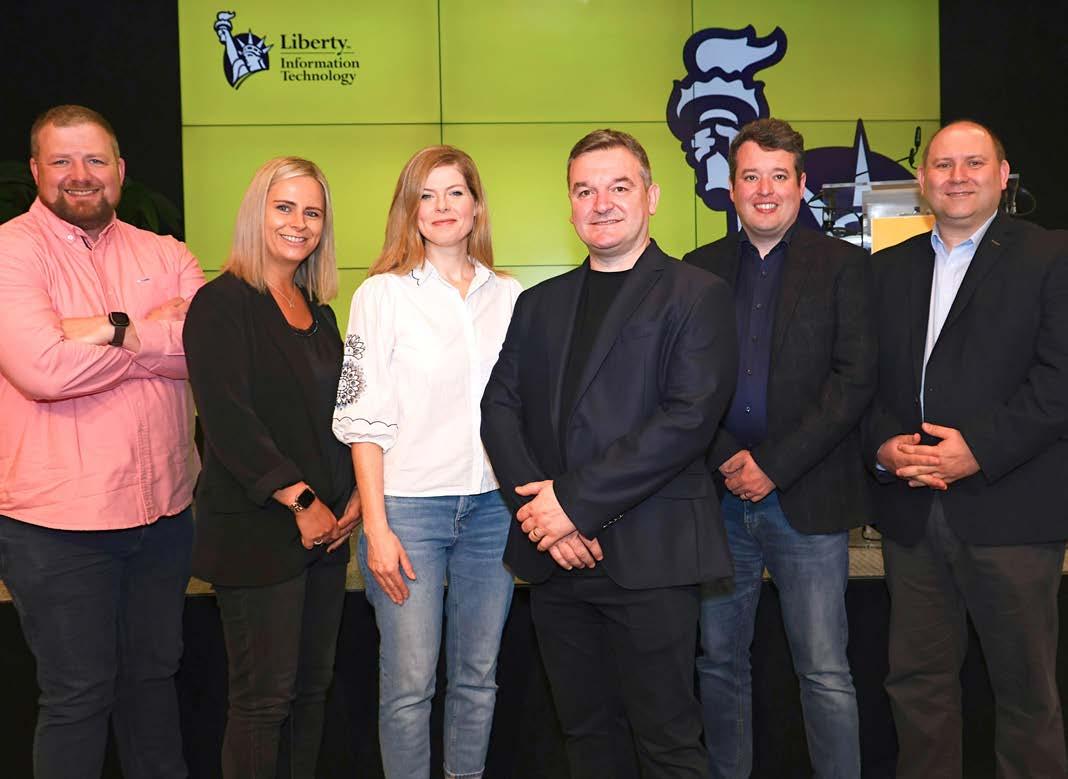
The multi-award-winning company develops technologies exclusively for its parent company, Fortune Top 100 Liberty Mutual Insurance, and already employs over 650 people across the island of Ireland, with offices in Belfast and Dublin.
Tony Marron, Managing Director of Liberty IT said: “Galway is one of Ireland’s most vibrant tech communities and we are delighted to open Liberty IT’s new hub here, giving us a physical presence in the West of Ireland as we continue to implement our ambitious growth plans. When looking into potential locations, PorterShed was the obvious choice for us as its outstanding contribution to supporting the growth and development of innovative businesses is very much aligned with the ethos of Liberty IT.”
“Over the last number of years, we’ve grown significantly and have developed our capabilities, particularly in the areas of data science, AI and machine learning. It’s a difficult time for many across our sector, with many downsizing across Ireland in recent months. Liberty IT are dedicated to supporting the incredible tech talent across the country and I am pleased to announce that we will be recruiting 100 new jobs over the next two years.
In the work we do with Liberty Mutual, we lead the way in engineering and innovation and work across complex enterprise business problems. Therefore, we are recruiting a wide range of roles in all areas of the business - Software Engineering, Data Science, ML Ops, Data Engineers, Designers and Consultants,” Tony continued.
Emma Mullan, Liberty IT’s Senior Director of Talent added: “Over many years we have been consistently recognised as a great place to work. We are really proud of the diverse, equitable, innovative and creative culture we have created, where our employees can thrive and develop their skills and careers. I am really excited to watch our Galway hub develop over the next few years and I have no doubt that our business will be all the richer for it!”
“We are delighted to have appointed Darren Muldoon, a current employee of Liberty IT, as Site Lead for the Galway hub. He will be central to building the vibrant and engaging culture for our growing workforce and helping us form strong partnerships with the local tech industry, strong partnerships with universities and education providers and strong partnerships with the community.”
Darren Muldoon joined Liberty IT as an Associate Software Engineer in 2012 and has progressed through the company over the last 11 years. He is the Chair of the Employee Resource Group, Pride @ Liberty IT, and last year was recognised by parent company, Liberty Mutual Insurance, at its first global Diversity, Equity and Inclusion Awards where he picked up an award for his work in ‘establishing and leading Pride at Liberty IT, living our values and acting as role models for DEI while raising awareness of LGBTQ+ topics throughout the
organisation’.
“I am proud to have been appointed Galway Site Lead and I look forward to helping Liberty IT grow and fully embed into the Galway tech community. The city’s tech industry is going from strength-to-strength so it is an exciting time for Liberty IT to have a physical presence here,” Darren said.
This project is supported by the Irish Government through IDA Ireland.
Minister for Enterprise Trade & Enterprise Simon Coveney said: “I am really pleased with the announcement that Liberty IT has chosen to develop its new hub in Galway, creating 100 new jobs. The West has become hugely important in the tech sector, and with this announcement they are continuing to demonstrate
their commitment to Ireland. The hub will allow for innovative and exciting new work to be undertaken, while availing of the wealth of talent available in Galway and surrounding areas. This talent is no doubt a driving force behind Liberty IT's decision to choose Galway for this investment. I would like to congratulate the team and wish them continued success in Ireland and this new project.”
Galway based Minister and Government Chief Whip, Hildegarde Naughton welcomed the announcement saying “the expansion of Liberty IT’s workforce here in Galway is not only a vote of confidence in our beautiful county of Galway but, critically, it is a clear commitment to and belief in the people of Galway and all that they have to offer. These 100
jobs bring the total to almost 2,000 new jobs announced in Galway so far this year; no surprise given the highly skilled talent pool that the West of Ireland has to offer. I want to extend my hearty congratulations to the entire team at Liberty IT and to your incumbent recruits.”
CEO of IDA Ireland
Michael Lohan said: “This announcement by Liberty IT that it’s to expand its presence in Ireland with a Galway hub is welcome news and further enhances Ireland’s emerging insurtech cluster. IDA Ireland remains committed to winning jobs and investments for regional locations across the country. I’d like to wish Liberty IT continued success.”
For further information on the roles currently available at Liberty IT go to www. liberty-it.co.uk
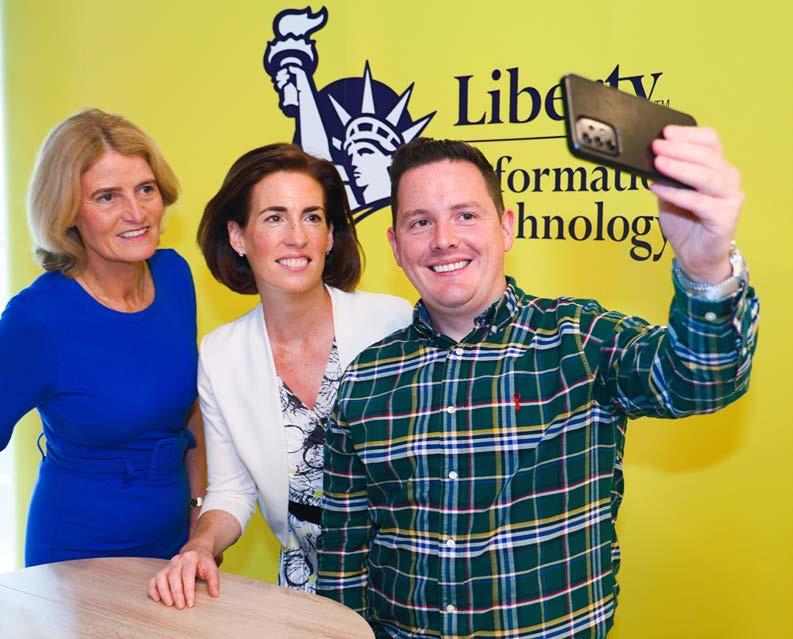

Northern Ireland’s Life and Health Sciences innovation sector is booming, with recent figures showing growth is exceeding Boston, the world’s number one health and life sciences supercluster.
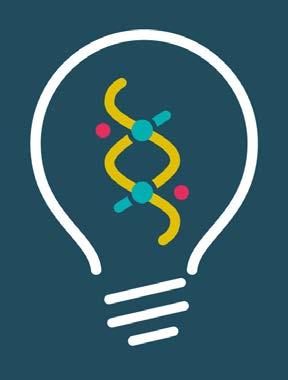
A total of 75% of all spinout companies from universities are health and life sciences businesses, with excellent capital efficiency showing market resiliency. Over the past year, the sector has had 9% jobs growth and 23% sales growth, yet is still underexplored and ripe for growth and investment.
We take a look at four NI companies shining on the world innovation stage:
Lisburn-based digital health company Cirdan Ltd are leading their field, partnering digital imaging with analytics to ensure more accurate, earlier diagnosis of breast cancer to accelerate treatment for patients and reduce the burden on healthcare systems, setting digital imaging precedents to support healthcare professionals diagnose patients earlier and relieving pressure on the patient, their families and health systems with the growing cancer epidemic.
They are global leaders in laboratory information systems, focused on helping pathology laboratories meet
their digital health needs. Cirdan were the first company to market a product focused on seamlessly collecting both text and images in the diagnosis of patients. They offer a complete endto-end laboratory solution through the development of hardware and software tools.
Cirdan have their headquarters in Lisburn with offices in Canada and Australia and provide 24/7, 365day support to their seventy global customers. During their start-up journey, they received grant funding from Invest NI and Venture Investments which include the Clarendon Fund Partners and Kernel Capital. Cirdan are part of Smart Nano NI, a consortium of local Northern Ireland technology companies and research institutions, who have recently received additional funding to develop game-changing advanced prototyping and smart manufacturing methods to deliver modern technologies. CEO Hugh Cormican said, “We are part of that wider life-tech group in Northern Ireland which hopes to be the economic power of the future.”
pHion Theraputics - Founder and CEO, Professor Helen McCarthy is Chair of Nanomedicine in the School of Pharmacy, a global top 40 School in the QS rankings. Professor McCarthy spun out the company in 2017 because
she could see that gene therapy would never fulfil its potential until a range of delivery systems were developed.
As one of the first therapeutic bio-techs to spin out of Queen’s, pHion had to develop its own roadmap. The company has had many offers to relocate to well-known bio-tech hubs in GB and the US. However, they have resisted, choosing instead to garner knowledge from experts externally and bring it back to Belfast. The goal is to create a new industry for many of the talented graduates from both local universities, and for those who have left NI and wish to return.
Winning both Invent and the AllIreland Seedcorn Competition in 2017 paved the way for the company’s early development of the use of this peptide technology to deliver mRNA vaccines. Since 2019, it has secured ten awards from Innovate UK and benefited from additional support from Invest NI, Medicines Discovery Catapult, and the Centre for Process Innovation.
“pHion sets high standards to
encourage each individual to exceed their potential. This is necessary because everything pHion does is a first; there are no peptidemRNA vaccine roadmaps to follow when it comes to the tests and quality checks for each product. pHion has to use solutions-based thinking in consultation with pharma experts so that together the team can educate others in this region on the optimal path to the clinic.”
Above all, though, Prof McCarthy is committed to translating her delivery technology to the clinic for patient benefit.
Belfast based Diaceutics study of US patient data recently showed how 64% of lung cancer patients did not receive access to the most effective medicines for them and their cancer type as a result of sub-optimal testing in the disease testing and diagnosis process.
The US-based study of lung cancer patients found inefficiencies when testing for a patient’s DNA and cancer type (a process known as biomarker testing), which is used to select a cancer treatment which is right for that specific individual.
This means patients are frequently unable to access the most effective treatment, tailored to their genetic make-up (known as Personalised Medicines) with considerable implications for their recovery and well-being.
Using data from 38,068 USA-based cases of those diagnosed in 2019 with advanced non-small cell lung cancer (NSCLC), this study reveals the barriers preventing patients from receiving these specialised treatments. This includes:
18% of patients not receiving the correct treatment because of inconclusive or false negative diagnosis test results, and 29% because, although tests were successfully carried out, the clinicians did not prescribe the treatment the patient could have benefitted from.
“Personalised Medicine brings a more promising future to the millions of patients undergoing cancer treatment,” said Peter Keeling CEO at Diaceutics.
founder of Respiratory Analytics, designed an AI-led respiratory device, aflo™, for those with asthma, after witnessing her partner and two children being hospitalised due to lifethreatening asthma attacks. Research shows almost 90% of sufferers do not master the right technique to get the best benefit from their inhalers, and aflo™ has been designed to do this automatically for them.
“It’s a terrifying thing to witness a family member having a life-threatening asthma attack. Inhaled medications are the cornerstone of asthma management and I’ve seen how difficult it is to get inhaler technique right to optimise these drugs, which is why this innovation was born.”
precision diagnostics.
“Contributing over £1.1bn GVA to the local economy, the region presents a key opportunity to benefit from this strong life sciences cluster.
Peter has driven Diaceutics to become a leader in innovative solutions that enable pharma to leverage diagnostic testing globally.
North West NI Entrepreneur Dr Susan Kelly was amongst this year’s 50 winners of Innovate UK’s Women in Innovation Awards who are developing novel solutions to major social, environmental and economic challenges.
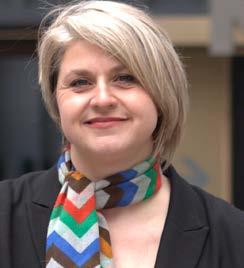
Dr Kelly, from Derry, Co-
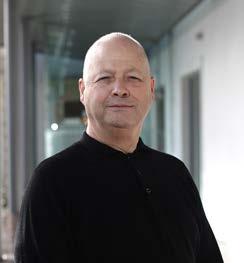
Health Innovation Research Alliance Northern Ireland (HIRANI), CEO Joann Rhodes said: “Precision medicine is the new generation of healthcare, with biomarkers and diagnostics essential for patient stratification, diagnosis and treatment. “The UK government is supporting the precision medicine sector, with millions of committed investment in genomic medicine, early diagnosis and detection and digital pathology.
“Northern Ireland is recognised by the UK government as a region which excels in diagnostics, making the nation an excellent location for biomarker discovery and
“With over 250 SMEs in health and life sciences, approximately 20,000 people work in the sector. And for every one job created in health and life sciences, a further two jobs are created in supporting sectors.
“Northern Ireland has the only fully integrated health and social care system in the UK, creating a truly unique dataset, benefitting from a stable 1.9m population for clinical trial recruitment.
“Underpinned by Northern Ireland Electronic Care Record (NIECR), with every citizen having a unique patient identifier, Northern Ireland has a safe and secure cradle-to-grave record for more than 500,000 people, with highly characterised clinical cohorts, for which Northern Ireland is working towards enabling access for enriched clinical trials.
“We are a small nation having a huge impact on global innovation”

q Version 1 is widely recognized for innovation and collaboration. How much do these values define your current roles?
Kathryn: Over the last five years Version 1 has made a significant investment in our innovation proposition and a large part of my role is ensuring that my team are fully aware of latest innovations in the IT industry. We place a lot of emphasis on upskilling our staff whether that’s training, attending conferences or upskilling certifications to share that knowledge and bring the latest innovations to our customers. This allows Claire and I to connect our customers to specialist teams within Version and of course all our customers will also have access to the wider 3000 people within the business to make sure their ideas come to fruition.
Since COVID remote working has become the norm. Today
many of my teams are working in different countries and with customers in different time zones so finding ways to collaborate is crucial and we work hard to adapt to each of our customers’ needs. Even taking the geographical spread of teams into account, every customer and every team has their own way that works for them so from a technology and a people perspective collaboration is key. While I don’t think we can totally replace face to face, particularly for certain project events, I also think it’s important for people to come together in person to celebrate successes.
Claire: From an innovation perspective, we've developed quite a strong story with our customers across various sectors and naturally we have acquired specific domain knowledge in terms of successfully delivering those projects. We can use that knowledge to drive many of our innovation programs
including our innovation labs and advisory services functions.
Version 1 has an innovation led collaborative environment and from my perspective working in a customer facing role, collaboration is an extremely important and an essential part of how we work with our customers. We always use different ways of working together in partnership to make it easier to achieve successful outcomes for them.
q Version 1 has won numerous awards for Great Places to Work . What makes Version 1 a great place to work for you?
Kathryn: For me personally it must be the people along with the fact that every day is different. Having such a diverse range of customers within the private sector means working with different customers to solve different problems which guarantees a lot of variation in the role each day.
I also spend time with a commercial team, such as Claire, to work on new proposals for our customers and generally the pace at which we operate is good. As part of such a growing organization this offers everyone more opportunities.
Claire: Yes, would agree with Kathryn. I also really like the fact that we're all in it together both as individuals and teams and all centered on our core values. Subsequently this translates into the conversations and relationships that we have with our customers and makes every day different and a joy to come to work.
q Version 1 has an impressive reputation for supporting women in tech. How important are these networks for you, personally?
Kathryn: We develop partnerships for local schools to support young woman coming into IT and for me that's the most important piece. It’s important to start right at the beginning and educating young girls to see that there
are a wide range of different roles within the sector. Young girls need to know IT is definitely an option for them as a future career.
Claire: I agree, it’s very important we reach these young people at an early age, not only from a learning and support perspective, but also the personal development opportunities that are afforded to them by being part of these networks. There are so many networks available today including Women in Tech and numerous meetups that can provide the ideal opportunity to develop different skills such as leadership and communication. It’s vitally important for organizations such as ours and senior people within the tech industry to enable this to happen.
q Effective teamwork is crucial to success. What qualities do you feel are essential for building and managing successful teams?
Kathryn: This is a key part of Version 1’s core values and that's how we operate… as a team.
We understand everyone brings something different and it's critical that our people feel valued and involved so while clear leadership is important, people really need to be empowered to make decisions themselves. Good communication upwards and downwards is also extremely important especially when people are in remote working environments.
Claire: I think it's important to put yourself in other people's shoes and listen to other people's perspectives. We would have quite diverse teams with a variety of different roles and bringing it all together seamlessly is essential for us to deliver successfully for our customers. Having a supportive environment plays an important part, it's impossible to get through your career without making mistakes, but making sure that you can see them quickly and learn from them is important. We have quite a niche
offering, with global locations and teams operating in different geographies and time zones, so understanding what is required to build those high performing teams is critical. As a result, we have invested extensively in delivering coaching, training and mentoring to our teams, both at an individual and team level, to ensure that this culture is embedded across the organization.
q Having both enjoyed a successful career in tech, what advice would you give to anyone considering coming into the sector?
Kathryn: My advice would be not to get too comfortable in your comfort zone. I know it sounds a bit of a cliché but you do only grow when you push yourself outside of that. Sometimes when things go bad at work it's often easy to get dragged down within that and hard to see the positive side but actually that's really when you learn the most and next time around, you'll be more prepared.
I also think it's important to be resilient. Right away I would say don't count yourself out of working in this industry if you didn't come from an IT background especially as there are so many different opportunities requiring different skillsets within Version 1. At the end of the day, we're all delivering IT services for people and as people we all interact with the services and everyone can bring a particular viewpoint and have something valuable to offer.
Claire: It's important to put yourself out there and put your hand up when opportunities come your way and step out of your comfort zone. I'd also say that you should probably continue to invest in your own learning and find an organization to work for that supports your ongoing development. Finally, I would say try not to have a career plan that's too rigid because opportunities and changes come out of the blue. Always be prepared for your ways of working to change and be conscious of the fact that your path may change too.
At PA Consulting, innovation is at the heart of everything we do- we believe in the power of ingenuity to build a positive human future, from tackling big societal issues like climate change and cyber security, to helping our clients solve the problems that matter to them.
As strategies, technologies and innovation collide, we create opportunity from complexity. Our diverse teams of experts across our business combine innovative thinking and breakthrough use of technologies to progress further, faster.
PA recently took on the challenge of keeping surfers safer- read on to find out how they leveraged their expertise across industries to completely rethink safety on the waves.
Surfing embodies the draw towards nature, escaping into a flow state that connects you to the sea. In many ways, it is the antithesis of technology. But technology could have a dramatic impact on preventing injury and death that is prevalent in the sport. Studies have shown that surfing is more popular than ever, but with this comes
a notable increase in head injuries (Dean, 2018).
Concussions can increase the risk of drowning due to the person’s confused, disoriented or unconscious state (Nathanson et al., 2002). Even a few seconds of unconsciousness can be fatal if there’s nobody around to rescue you. Several of our designers are keen surfers, so this problem is close to home. We wanted to find a solution that could help reduce surfer fatality without hindering surfers doing what they love—so we created OBEX to solve that problem.
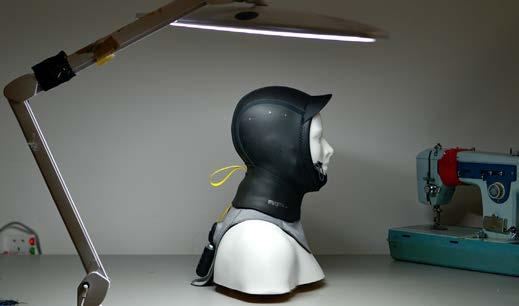
OBEX is a surf hood with integrated sensors that activate an inflatable bladder (heat-sealed nylon urethane). This bladder is discreetly stored within the collar of the hood. Two canisters of CO2 inflate the bladder. These are stored in a pocket between
built a specialist team of design, engineering, UX, garment, and fabric expertise supported by advanced prototyping tools and facilities.
the shoulder blades. Both canisters are also connected to a separate pull tab located in the collar for manual activation if necessary. The impact sensors that sense an incident are sandwiched between the neoprene and thermal layers using flexible circuitry. Seconds count when in difficulty at sea. Following a high impact collision, OBEX will inflate to keep the surfer safe, as well as alert fellow surfers both in the water through haptic notifications, and on land via the OBEX app.

Many companies have struggled to design compelling smart garments. Tech companies can be naïve when it comes to garment design, and the fashion industry can struggle when it comes to hardware.
The formula for wearables to succeed lies in the unification of the hard and soft goods disciplines. In response to this, we have
Even in activities like surfing, where people escape to nature, embedded technology can be a lifesaving companion. A central challenge of this project, and with all wearables, is how to unify hard and soft goods disciplines.
Consequently, the success of our solution lies in the integration of design, engineering, UX, garment and fabric expertise, supported by advanced prototyping tools and facilities. Close collaboration between our design, engineering and apparel experts will continue to deliver smart garments that augment people's capabilities and well-being.
Tom Keating, Vice President at Proofpoint, highlights how cyber attacks are forcing companies to become more creative when approaching their cybersecurity
The modern threat landscape is rapidly evolving - with larger attack surfaces, more access points, and increasingly sophisticated cyberattacks, particularly in the wake of recent large global events.
After two years of pandemic-induced disruption, many parts of the world have returned to something close to “business as usual”. And for cyber criminals, that means getting back to innovating, iterating, and broadening their range of attacks to successfully siphon sensitive data from organisations and employees that may be better prepared.

There’s no denying that email-borne attacks remain rife – and successful. In fact, our 2023 State of the Phish Report revealed that among the global organisations that experienced attempted email-based phishing attacks last year, eight in 10 organisations (84%) experienced at least one successful attack.
And while conventional phishing remains successful, many threat actors have started shifting to newer techniques, such as telephone-oriented
attack delivery (TOAD) and adversary-in-the-middle (AitM) phishing proxies that bypass multifactor authentication. These techniques have been used in targeted attacks for years, but 2022 saw them deployed at scale. Proofpoint researchers have also seen a marked increase in sophisticated, multi-touch phishing campaigns, engaging in longer conversations across multiple personas. Whether it’s a nation state-aligned group or a BEC actor, there are plenty of adversaries willing to play the long game to get what they want from an organisation.
While many threat actors are still experimenting, what remains the same is that attackers exploit people, and they are the most critical variable in today’s attack chain. To keep pace with the new tactics deployed by threat actors, it is imperative for organisations to assess their cybersecurity posture, and more importantly, consider how they can innovate and ensure their people are a strong line of defence.
To address this, Proofpoint continues to deliver on innovations that empower organisations to bolster their defences. So far this year, we have announced a host of
innovations across our Aegis Threat Protection, Identity Threat Defense and Sigma Information Protection platforms, empowering organisations to stop malicious email attacks, detect and prevent identitybased threats and defend sensitive data from theft, loss and insider threats.
These new innovations further enhance our leading threat and information protection platforms, in addition to our newly formed Identity Threat Defense business (formerly known as Illusive). Identity theft is a growing threat in today’s digital landscape. By compromising just one employee’s identity, attackers are able to slip through existing defenses. And they can complete their attacks in a matter of days. Proofpoint Identity Threat Defense helps organisations to “break the attack chain” by detecting and preventing identity risk, stopping lateral movement and privilege escalation. It also allows organisations to augment and safeguard their
productivity investments, such as Microsoft 365, with maximum deployment flexibility.
Another key advancement in our solutions is our Supplier Threat Protection offering. It only takes a quick look at recent headlines on the big cyber breaches to see that trusted supplier relationships are another growing attack vector. Our data also illustrates this threat, with 69% of organisations experiencing a supply chain attack within the past year, and global CISOs rating it as one of their top concerns. With Proofpoint Supplier Threat Protection organisations can detect compromised supplier accounts so that security teams can swiftly investigate and remediate. This new product proactively monitors for and prioritizes known compromised thirdparty accounts, simplifies investigation with details on why the account is suspected compromised and which employees recently communicated.
Whatever the vector or technique, one thing remains the same: cybercriminals are focused – forever honing their skills and techniques to get what they want. If organisations aren’t doing the same, there can only be one winner.


